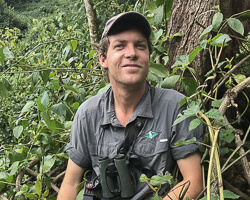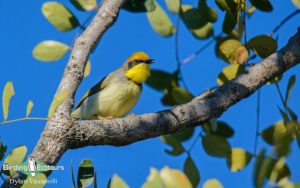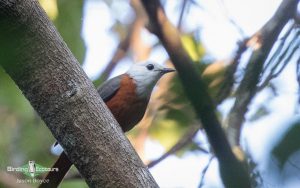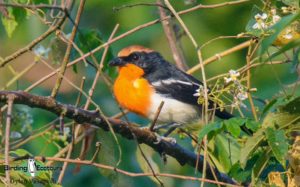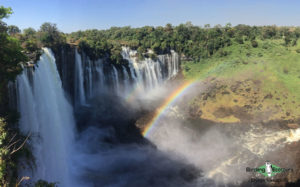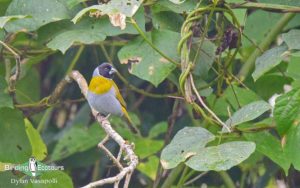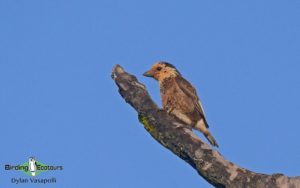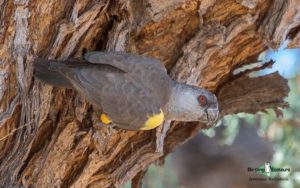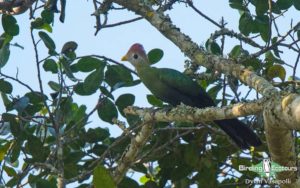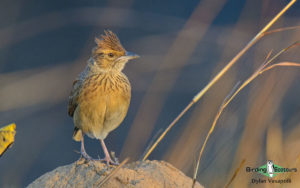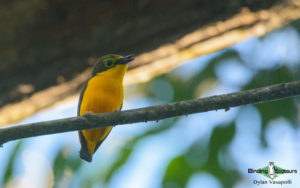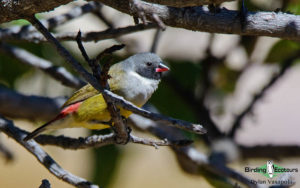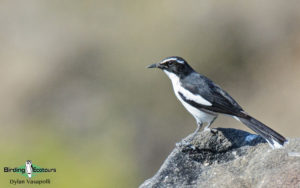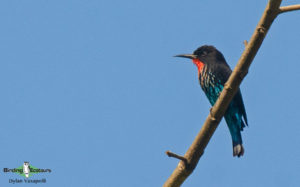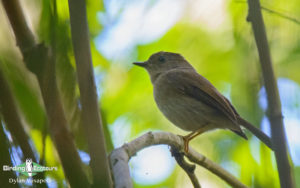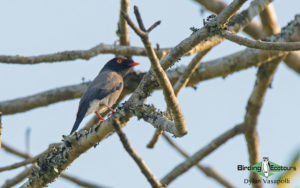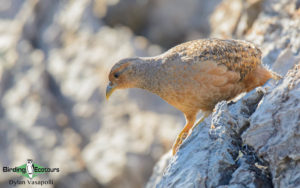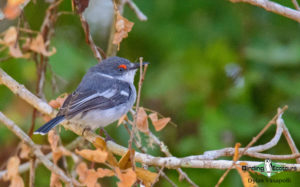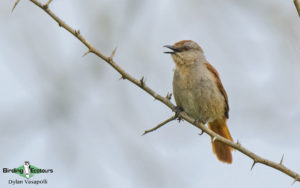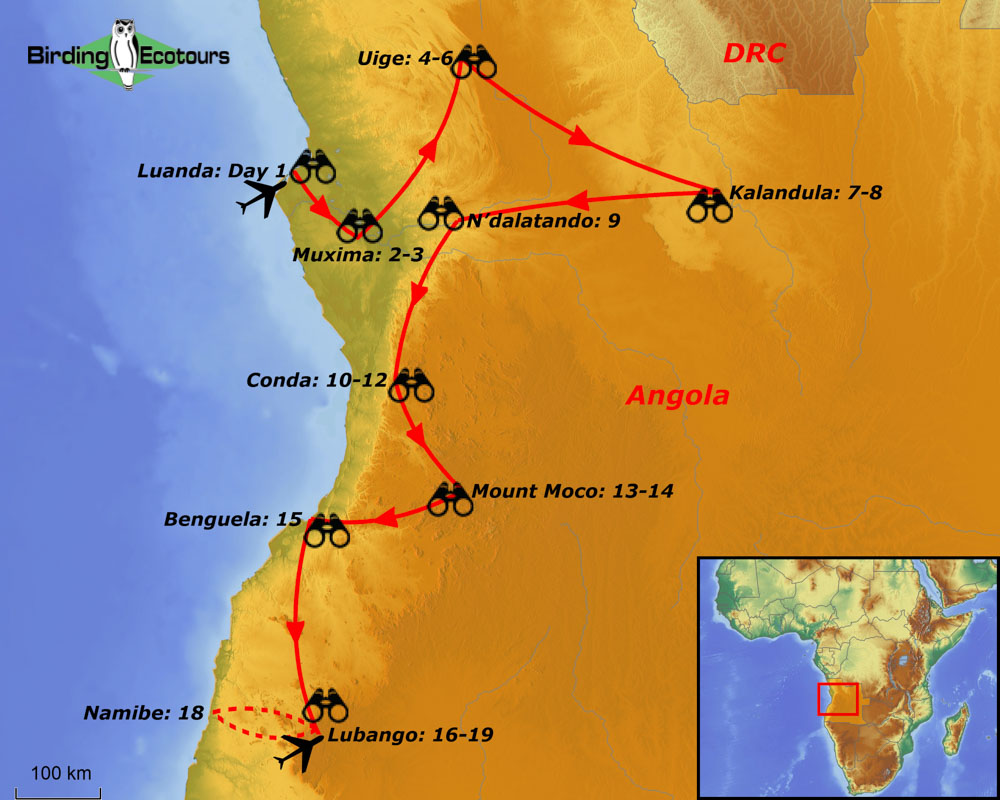Birding Tour Angola: Africa’s Best-kept Birding Secret
Go to: Angola Birding Tours | Birding Tours in Africa | All our birding tours
Birding Tour Angola: Africa’s Best-kept Birding Secret
June 2024
Since Angola’s three-decade-long civil war ended in 2002, the country has enjoyed peace and stability, along with a massive surge in infrastructural advancements, opening the country up to tourism (much to the delight of birders who want to see its 1,000+ bird species including 15 superb endemics and a suite of other localized birds). During the initial post-war years, Angola was deemed to be a country only for ‘hard-core’ tourists, and even the few birding tours available were typically overland camping adventures. Fortunately, this has changed somewhat in the last few years, and while a sense of adventure is still required, an ever-improving road network makes this country easier to traverse, and with suitable accommodation options available along the entire route, this tour has no overland camping.
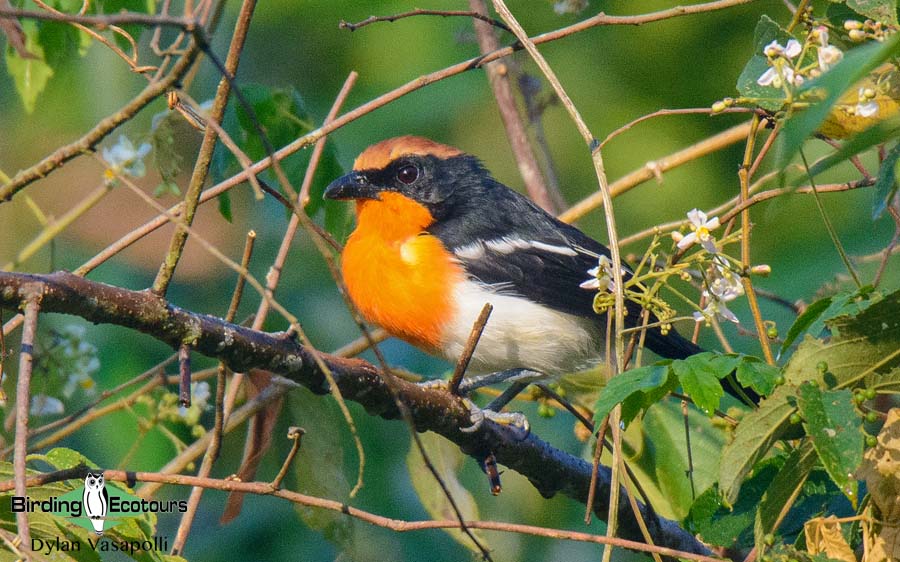
Angola has a massive bird diversity, over 1000 species occurring within its borders, of which 15 are true endemics, while countless other near-endemics and highly localized species feature prominently. This is all a testament to the many habitats within the country and ultimately the fantastic birding Angola offers, making it without a doubt one of the finest birding countries in Africa and a destination not to be missed by any world birder.
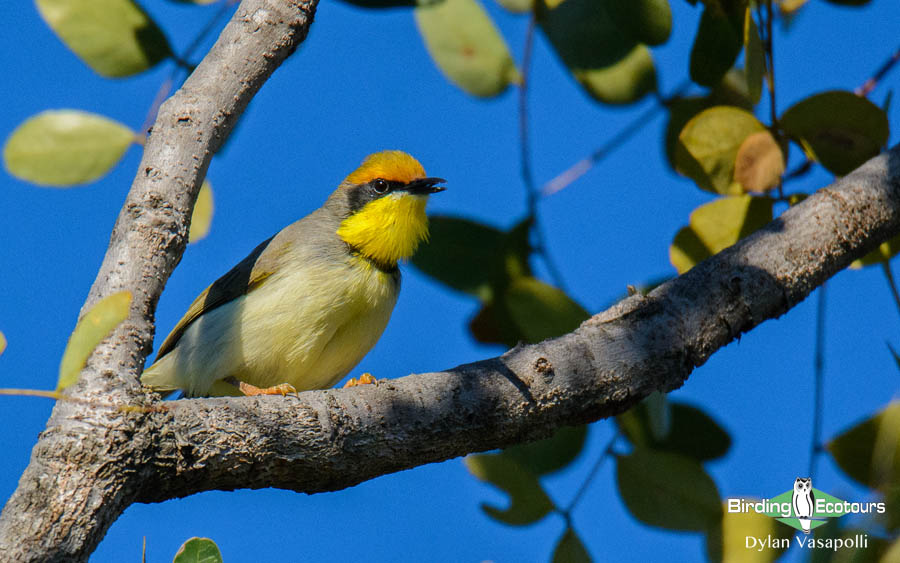
This comprehensive tour takes us through the western parts of the country and to all the key birding areas. Beginning in the capital, Luanda, our first birding foray sees us visiting the dry woodlands of the Kissama National Park before venturing north into the exciting and seldom-visited scarp forests, more consistent with Equatorial Africa. We then gradually begin working our way south, first taking in the spectacular Kalandula Falls and their exciting swamp forests before calling in at the famous Kumbira Forest, outside of Gabela – a town which has three endemic species named after it. We will seek out many endemic species here before transferring even further south to the highest mountain in the country, Mount Moco (2,620 meters or 8,600 feet). We then journey to the coast and the town of Benguela, where we get our first sampling of the many more iconic “Namibian” specials (which are now also accessible in Angola), before reaching our end point in Lubango, from where we explore the spectacular Tundavala escarpment and the dry coastal plain to the Namibe Province.
This well-designed route gives us a chance for all the country’s endemics, near-endemics, and specials, including such rare and poorly known species as the spectacular Braun’s, Gabela, and Monteiro’s Bushshrikes, Gabela Helmetshrike, White-headed Robin-Chat, Swierstra’s and Grey-striped Francolins, Red-crested Turaco, White-fronted Wattle-eye, Pulitzer’s Longbill, Angolan Slaty Flycatcher, Angolan Cave Chat, Gabela Akalat, Bocage’s Sunbird, Bocage’s Weaver, and Angolan Waxbill. Many other more widespread species are also best sought within Angola and include the likes of Finsch’s Francolin, Anchieta’s Barbet, Margaret’s Batis, Yellow-bellied Wattle-eye, Angolan Lark, Black-and-rufous and Red-throated Cliff Swallows, Tit Hylia, Black-necked Eremomela, Black-collared Bulbul, Pale-olive and Falkenstein’s Greenbuls, Bubbling Cisticola, Rufous-tailed Palm Thrush, Bates’s and Bannerman’s Sunbirds, Woodhouse’s Antpecker, Landana Firefinch, and Dusky Twinspot. Almost all of the Namibian ‘specials’ feature on the route as well, including Hartlaub’s Spurfowl, Rüppell’s Korhaan, Monteiro’s Hornbill, Rüppell’s Parrot, White-tailed Shrike, Benguela Long-billed Lark, Rockrunner, Carp’s Tit, Bare-cheeked Babbler and Cinderella Waxbill. On top of these mouthwatering species we should tally up an impressive species list and expect our total to exceed 500 species. We look forward to welcoming you on our Complete Angolan Birding Tour as we venture into one of Africa’s best-kept secrets!
This tour can be combined with our São Tomé and Príncipe birding tour immediately after, as there are direct flights from Luanda to these endemic-rich islands.
Itinerary (19 days/18 nights)
Day 1. Arrival in Luanda
Today is your arrival day, and you can arrive at your leisure into the Angolan capital, Luanda. We will transfer to the comfortable Kwanza Lodge, south of the city, where we will spend the night. The tour formally begins in the afternoon/evening with a group dinner.
Overnight: Kwanza Lodge, Luanda
Day 2. Transfer from Kwanza Lodge to Muxima
We will spend our first morning in the country birding around the grounds of the lodge, along with the nearby Kwanza River mouth, where we will primarily search for Royal and Damara Terns and Mangrove Sunbird. Many other species are possible, and we will likely also find our first waterbirds, including Woolly-necked Stork, Grey Heron, Little Egret, and Water Thick-knee. Palm-nut Vultures are regular around the lodge, and we will also be sure to keep an eye out for Blue-breasted Kingfisher, among the more common kingfisher species, such as Woodland, Malachite, and Pied Kingfishers. The sought-after Olive Bee-eater, along with Little Bee-eater, hawk insects over the river, while the surrounding scrub holds the near-endemic Bubbling Cisticola along with Spectacled Weaver. While searching for the unique Mangrove Sunbird we are also likely to come across other sunbird species, including Purple-banded, Collared, and Scarlet-chested. Long-legged Pipit also frequents the more open areas. We will also journey north toward the extensive mudflats of the Mussulo bay, arguably the country’s best wader/shorebird-watching site. Stately Greater Flamingos patrol the shallows here, with raptors such as African Fish Eagle and Western Osprey also regularly occurring here. The exposed tidal mudflats, however, will form our primary focal point, and we will search for a variety of species, including Grey, Kittlitz’s, and White-fronted Plovers, Whimbrel, Eurasian Curlew, Ruddy Turnstone, Curlew Sandpiper, and Sanderling. Collared Pratincole frequents the drier regions away from the mudflats, while tern/gull roosts will be searched for Kelp and Grey-headed Gulls along with other tern species such as Caspian and Sandwich Terns. The surrounding scrub plays host to species such as Red-faced Mousebird, Angolan Swallow, Bubbling Cisticola, Northern Grey-headed Sparrow, and Red-headed Finch. Following our time here we will transfer to the south-eastern corner of the Kissama National Park to the Muxima area, where we will spend two nights. and begin our hunt for the first of the country’s true endemics. The vegetation will change to a much drier, open, baobab-dominated woodland, and the area hosts some more localized species for Angola, although widespread elsewhere in southern Africa, such as Purple Roller, Southern Yellow-billed Hornbill, Southern White-crowned Shrike, and Red-billed Buffalo Weaver, among others. We will likely arrive in this area later in the day and begin birding in earnest the following morning.
Overnight: Muxima
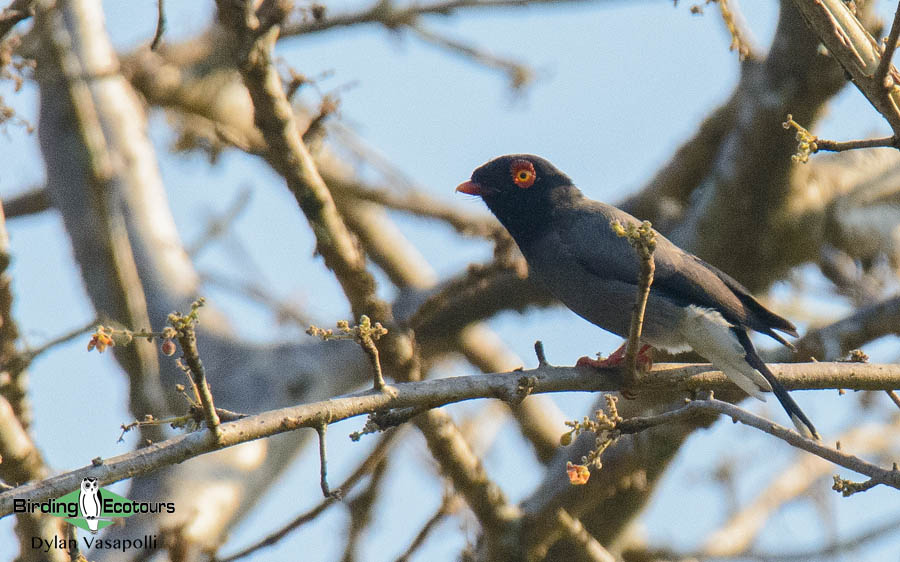
Day 3. Birding Muxima and Kissama National Park.
We have a full day to explore this area and will take a few specific tracks, venturing deeper into the area. We again see a slight habitat change, heading into a lusher area, crisscrossed with dry riverbeds and dense thickets. It is these areas that hold the local major specials and where we will spend the bulk of our time. The dry riverbeds are home to large, mature, acacia-type trees, and we will search these areas for the highly prized and localized endemics, Monteiro’s Bushshrike and Gabela Helmetshrike, along with the more widespread, near-endemic Red-backed Mousebird. The denser thickets host one of the other endemic targets of the area, White-fronted Wattle-eye, and also support the endemic Hartet’s Camaroptera and the near-endemic Pale-olive Greenbul, although these latter two are more widespread and thus also possible elsewhere on the trip. This area also gives us our best chance for the difficult-to-see, endemic Grey-striped Francolin, and we will be sure to keep a beady eye on the tracks watching out for this scarce gamebird among its more common cousin, Red-necked Spurfowl. Also best sought in this area is the near-endemic Golden-backed Bishop, and although we will not be seeing these birds in their breeding plumage, their unique structure and plumage make them easy to identify.
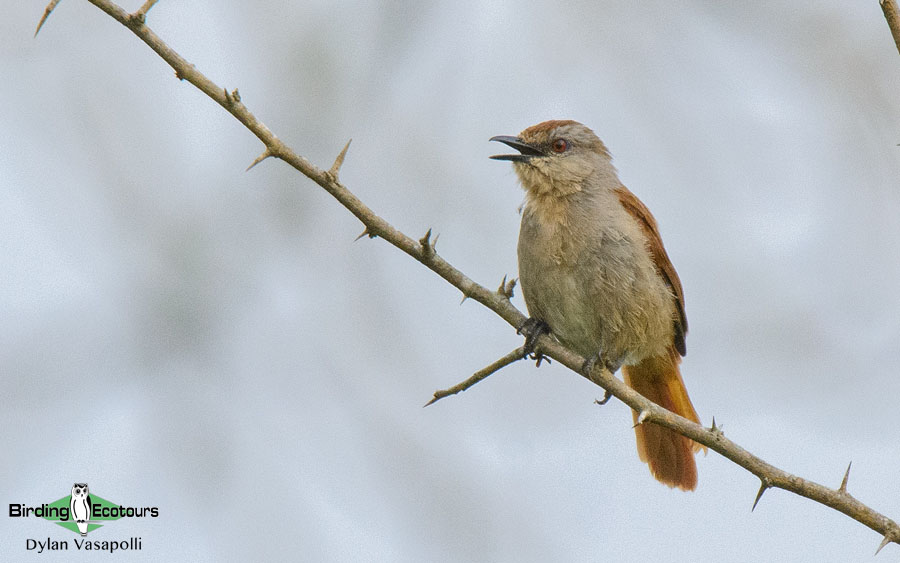
Aside from the above species, which will be our major targets, this area is rich in birdlife, and we’re likely to come across many other species. Possible raptors include Palm-nut Vulture, Brown Snake Eagle, Bateleur, Lizard Buzzard, African Goshawk, and Yellow-billed Kite, while we will also be sure to watch the skies for the sought-after Böhm’s and Mottled Spinetails, along with Mosque Swallow, all of which breed in the many baobabs strung throughout the area. Emerald-spotted Wood Dove occurs alongside Namaqua Dove, and some of the larger species in the area include Grey Go-away-bird, Lilac-breasted Roller, Green Wood Hoopoe, and Crowned Hornbill. Colorful Swallow-tailed Bee-eaters frequent the tree tops, while a variety of Woodpeckers, including Bearded, Cardinal, and Golden-tailed, prefer the larger trees, and Brown-hooded and Striped Kingfishers sit quietly in the mid-strata. The larger riverine trees also host many other passerines, including Orange-breasted Bushshrike, Brubru, White-crested Helmetshrike, Black-headed Oriole, Yellow-bellied Greenbul, Long-billed Crombec, Arrow-marked Babbler, Violet-backed Starling, and Grey Tit-Flycatcher, while the denser thickets play host to other sought-after species such as Angolan Batis, Swamp Boubou, Green Crombec, Forest Scrub Robin, Rufous-tailed Palm Thrush, and Dark-backed Weaver.
Overnight: Muxima
Day 4. Transfer from Muxima to Uige
We have the morning available to further explore the Muxima area for any possible species we have yet to find before pressing onward to today’s ultimate destination at Uige. Our route will see us head through the northern section of the Kissama National Park and arguably one of the finest baobab forests in the world – a truly spectacular sight to behold, before arriving in the Catete area, where we will explore the floodplains associated with the Kwanza River for some wetland birding. Here we will try for White-faced Whistling Duck, Yellow-billed Stork, African Openbill, Squacco, Striated, Rufous-bellied, and Purple Herons, Great Egret, Black Crake, Allen’s Gallinule, and African and Lesser Jacanas, among others. The open lands surrounding the floodplains host Blue-spotted Wood Dove, Diederik Cuckoo, Banded Martin, and Village and Slender-billed Weavers. From here we will complete our long journey to Uige, with a possible birding stop near the small village of Quibaxe, for our first taste of some of the northern scarp forest birds (see under Days 5-6 for an account of species in the area).
Overnight: Uige
Days 5 – 6. Birding Quitexe and surroundings and the Damengola Forest
The northern scarp forest of Angola holds arguably some of the most exciting birds in the country, and, although the area doesn’t host many endemics, it is the chance of finding rare and somewhat unknown species within these relatively unexplored forests that is one of the major drawing cards to the area. Our main focus will be on the Damengola Forest and surroundings, which gives us access to a far more extensive section of these northern scarp forests. A great many species are to be sought in the area, including more Guinea-based species along with more central African species. Foremost of our targets here will be the beautiful, but incredibly localized, endemic Braun’s Bushshrike. This rare and poorly known species is one of Angola’s most sought-after birds and will have the bulk of our time and effort being dedicated toward seeing it. Some of the other more important specials to be sought include such rare and infrequently seen species as African Piculet, Tit Hylia, and White-collared Oliveback (nearly 1000 kilometers outside of its known range) although difficult, Blue-headed Crested Flycatcher, Yellow Longbill, and Black-bellied Seedcracker. While exploring these forests the mournful hoots of Afep and Western Bronze-naped Pigeons are never far away; however, as is customary, it takes some time and patience to track these species down. Blue-throated Rollers perch in the open above the canopy, and the massive Black-casqued Hornbills flap noisily between perches, while Red-fronted Parrots commute overhead in the mornings and evenings and Yellow-crested Woodpeckers drum from the massive trees. The calls of Grey-headed and White-breasted Nigritas ring out regularly, while large and boisterous Guinea Turacos bound in the tree tops. Not to be outdone, the massive Great Blue Turaco occurs in the area as well and never fails to impress. Angola’s national bird, the endemic Red-crested Turaco, occurs as well but is uncommon here and best searched for elsewhere on the trip.
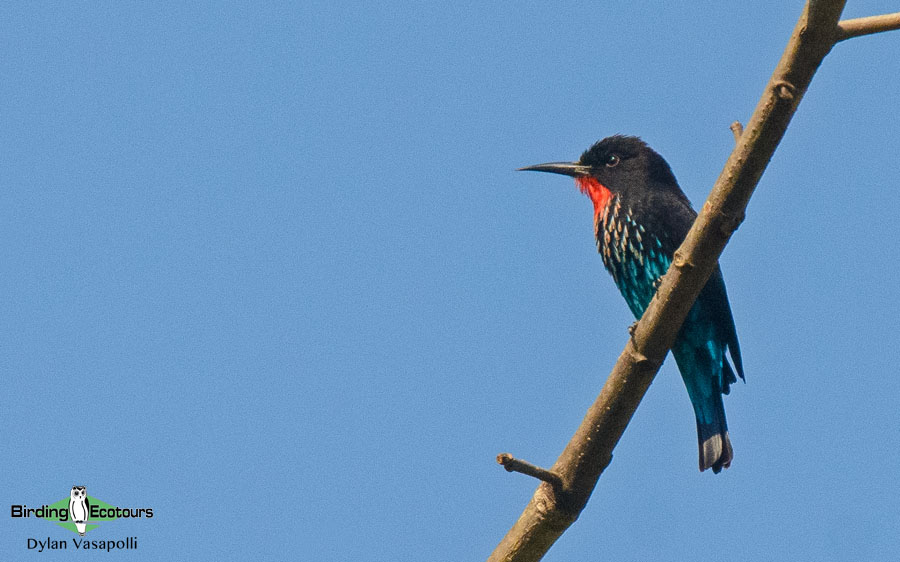
Black Bee-eater flits overhead, and this spectacular bird is fortunately a regular sight in the area. However, the highly prized Chocolate-backed Kingfisher is more difficult to locate, but both will be targeted. Piping and African Pied Hornbills are often heard before being seen, as is true with the many Barbets occurring here, such as Naked-faced, the strange Bristle-nosed, Hairy-breasted, and Yellow-billed, along with Speckled and Yellow-rumped Tinkerbirds. A number of Starlings occur in these forests, and we’ll be on the lookout for Splendid, Chestnut-winged, and Narrow-tailed, all regularly attending fruiting trees. Sunbirds are also many and diverse, with Little Green, Grey-chinned, Collared, Green-headed, Blue-throated Brown, Olive, Olive-bellied, and the beautiful Superb all occurring. Other species to be sought here include Tambourine Dove, African Emerald Cuckoo, Blue Malkoha, African Pygmy Kingfisher, Buff-spotted Woodpecker, Angolan Batis, Chestnut Wattle-eye, Black-and-white Shrike-flycatcher, Bocage’s Bushshrike, Tropical Boubou, Pink-footed Puffback, Mackinnon’s Shrike, Black-winged Oriole, Rufous-vented Paradise Flycatcher, Petit’s and Purple-throated Cuckooshrikes, Velvet-mantled Drongo, Yellow-throated Nicator, Swamp Palm Bulbul, Simple, Slender-billed, Little, Plain, and Yellow-whiskered Greenbuls, Red-tailed Bristlebill, Black-throated Apalis, Banded and White-chinned Prinias, Yellow-browed Camaroptera, Brown Illadopsis, Dusky-blue Flycatcher, Fraser’s Rufous Thrush, Forest Scrub Robin, Grey-throated Tit-Flycatcher, Vieillot’s Black and Yellow-mantled Weavers, and Crested and Red-headed Malimbes. Rolling grassy hills surround these scarp forests and play host to many other interesting species, top of them being the unique Black-collared Bulbul. Not to be forgotten are species such as Northern Fiscal, Brown-backed Scrub Robin, Chattering Cisticola, Moustached Grass Warbler, African Yellow Warbler, Black-winged Red Bishop, Yellow-mantled Widowbird, Red-headed Quelea, Orange-cheeked Waxbill, Black-and-white Mannikin, Landana Firefinch, and the snazzy Brown Twinspot. We will also be on the lookout for some of the rarer and more uncommon species, including Yellow-throated Cuckoo, Red-rumped Tinkerbird, African Shrike-flycatcher, Forest Swallow, Scaly-breasted Illadopsis, Pale-fronted Nigrita, and the poorly known Woodhouse’s Antpecker.
Overnight: Uige
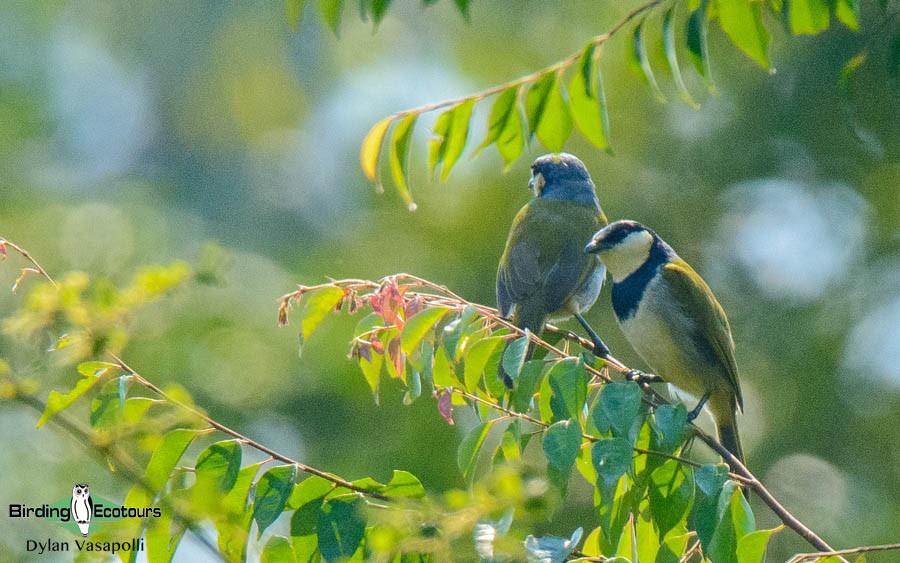
Day 7. Transfer from Uige to Kalandula
After some great birding in the northern scarp forests we depart this area, bound for another fantastic birding zone, the greater Kalandula area. This will likely be quite a long drive, as sections of the road are very slow, and we anticipate arrival in the afternoon, following a morning departure. This area is home to arguably one of Angola’s greatest natural wonders, the spectacular Kalandula Falls, and our afternoon will include a visit to the falls, where we’ll admire their beauty before retiring to our comfortable hotel within view of the falls.
Overnight: Kalandula
Day 8. Birding around Kalandula and Kinjila
Today will be another exciting day, as we head into the swamp forests near Kalandula for, primarily, the sought-after White-headed Robin-Chat. This rare, localized, poorly known, yet spectacular bird is another one of the major avian drawing cards on this tour! Initially thought to be extinct, this species was only rediscovered as recently as in the 1990s, and it is now known only from three separate locations, with a very small number of birders fortunate enough to have seen it. This species’ ringing call echoes through the forest, but it is a shy species, and patience is required to obtain visuals. While this will be our main target, there are a host of other tantalizing species occurring in these swamp forests and their surroundings as well. The diminutive White-spotted Flufftail frequents these swampy areas, while the vocal Ross’s Turaco bounds through the tree tops. The upper reaches also play host to the shy Olive Long-tailed Cuckoo, Scaly-throated Honeyguide, Honeyguide Greenbul, and Brown-headed Apalis, while the denser reaches lower down host Grey-winged Robin-Chat, Cabanis’s Greenbul, and Black-throated Wattle-eye. Stands of miombo-type woodland surround the swamp forests, and we will be spending some time slowly working our way through these woodlands as well.
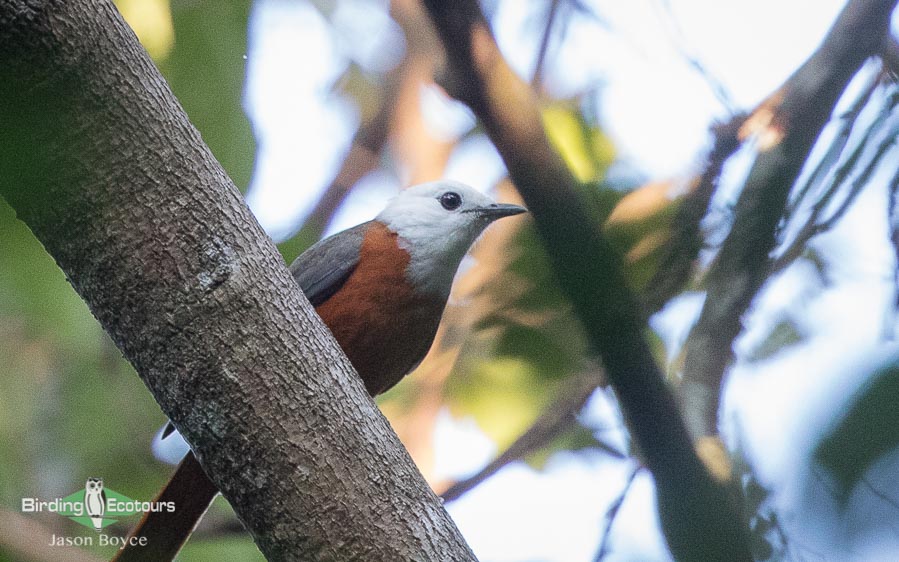
This is arguably the best place in the world for the sought-after Anchieta’s Barbet, while some other key targets in these woodlands will be Thick-billed Cuckoo, Black Scimitarbill, Gorgeous Bushshrike, White-winged Black Tit, Miombo Wren-Warbler, Yellow-bellied Hyliota, Sharp-tailed Starling, Miombo Scrub Robin, a trio of scarce Sunbirds, Anchieta’s, Bates’s, and Bannerman’s, Orange-winged Pytilia, and Broad-tailed Paradise Whydah. Miombo woodland birding isn’t always the easiest, as it is often quiet for long periods of time, as the birds frequent ‘feeding parties’ – large mixed groupings of birds moving through the woodland feeding – and there is usually only activity when you encounter one of these parties. Other species occurring in the area include Red-crested Turaco (uncommon), Meyer’s Parrot, Chinspot Batis, Black-crowned Tchagra, Retz’s Helmetshrike, African Golden Oriole, Whistling Cisticola, African Thrush, Pale Flycatcher, Western Violet-backed, Amethyst, Green-throated, Variable and Copper Sunbirds, Yellow-throated Petronia, and Golden-breasted Bunting. African Barred Owlet occurs in the area, but we will need some luck to find it during the day. Nearby rivers are host to a huge number of highly prized Red-throated Cliff Swallows, which breed under some of the larger bridges, and we will search through the throngs of cliff swallows for scarcer birds such as White-bibbed Swallow and even Brazza’s Martin. The quieter back-reaches of the rivers are home to Shining-blue and Malachite Kingfishers, while the surrounding reeds and damp grasslands host Blue-breasted Bee-eater, Marsh Tchagra, Moustached Grass Warbler, Compact Weaver, Fan-tailed, Yellow-mantled, and Red-collared Widowbirds, Red-headed Quelea, Orange-breasted Waxbill, and Fülleborn’s Longclaw. Even the smallest of bushes near these rivers host the noisy Yellow-throated Leaflove. African Scops Owl is easily found here at night, and we will try for Fiery-necked and the spectacular Pennant-winged Nightjars as well.
Overnight: Kalandula
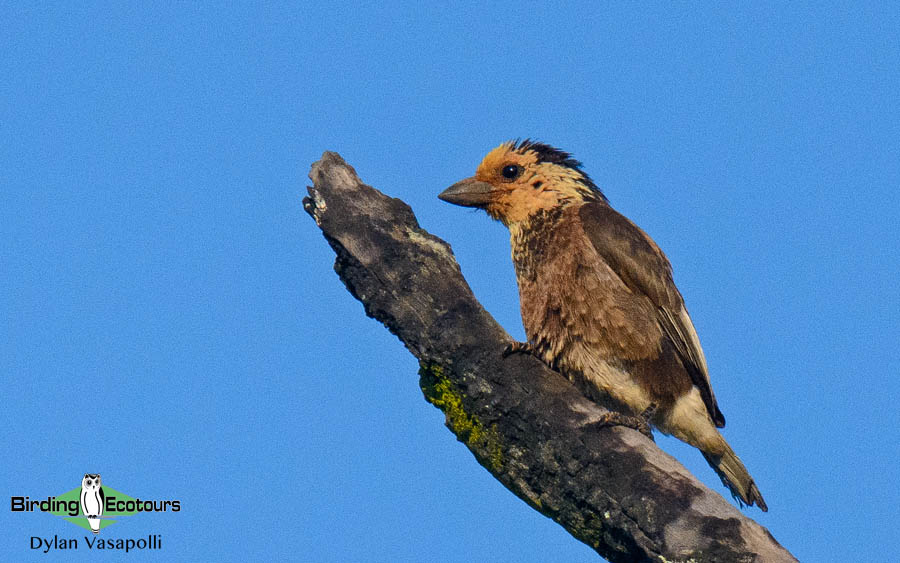
Day 9. Transfer from Kalandula to N’dalatando
We have the morning available for further birding in the greater Kalandula area to try for any birds we may have missed before departing this area with its scenic waterfalls bound for N’dalatando, where we will stay for a night. The drive is not too far, and with a birding stop or two, such as at the Lucala River for Rock Pratincole, we should arrive in the early afternoon, where we’ll check into our hotel before setting off for the nearby Tombingo Forest, where we’ll spend the rest of the afternoon. Essentially part of the far outlying reaches of the vast northern scarp forests, this area hosts many species similar to those we’re likely to have seen birding around Quibaxe and Quitexe, but also allows us a further opportunity to try for some of the species we may have missed. Flocks of Red-fronted Parrots commute overhead, while Trumpeter, Piping, African Pied, and Crowned Hornbills noisily move about. A large spectrum of barbets occurs, and we should encounter more of the strange Bristle-nosed and Naked-faced Barbets. We will also watch out for the scarce Cassin’s Honeybird here, along with Brown-eared Woodpecker, while the forest is a great place to catch up with Chestnut Wattle-eye, Black-winged Oriole, African Blue Flycatcher, Yellow-whiskered and Honeyguide Greenbuls, Red-tailed Bristlebill, and Rufous-crowned Eremomela. Green Hylia’s soft call rings out continuously, but the bird can be tricky to spot, while Sooty Flycatcher usually perches atop the highest branches of the canopy and is usually a bit easier to find. This is also a good area for the scarce Tit Hylia, we have another chance here at White-spotted Flufftail if we missed this bird around Kalandula, and rarer species such as Woodhouse’s Antpecker occur as well.
Overnight: N’dalatando
Day 10. Birding Tombingo Forest and transfer to Kumbira Forest
We have the morning available for birding around Tombingo Forest, searching for the above-mentioned species, before beginning the drive to another of Angola’s more famous birding areas, Kumbira Forest. As is consistent with most of the drives between sites in Angola, this will take some time due to slow roads, and we will likely only arrive in the late afternoon, from where we will journey to Conda, where we will spend the night.
Overnight: Conda
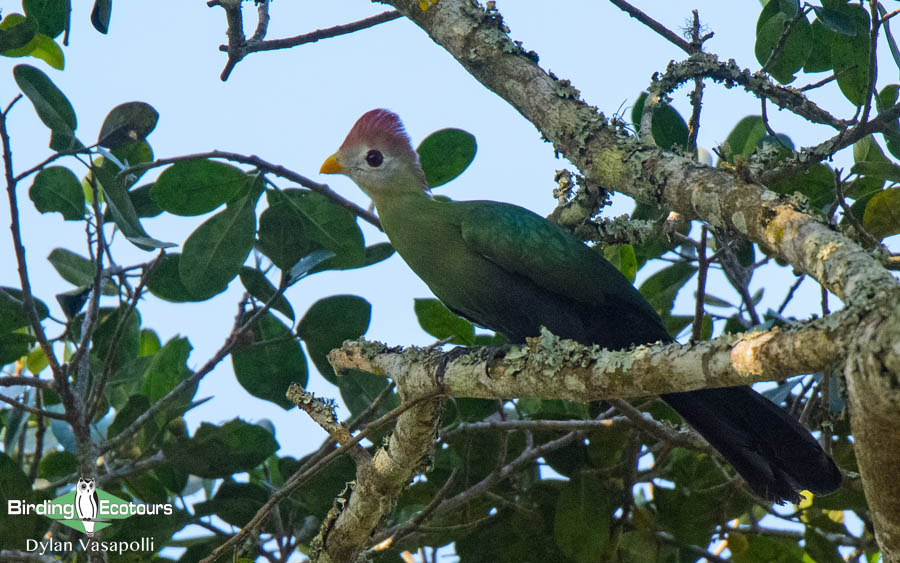
Days 11 – 12. Birding Kumbira Forest
We have two full days available to explore the extremely fragmented secondary forest patches that remain at Kumbira Forest. Despite this area being a recognized IBA (Important Bird Area), the entire region is still under pressure from slash-and-burn agriculture, and the forest will likely only become more fragmented, which doesn’t bode well for the area’s many specials. The early stages of the bumpy track heading towards the forest initially pass through more scrub/thicket-based habitat, which hosts one of the key targets of the area, the endemic Pulitzer’s Longbill. This rare and difficult-to-find species is always tricky to pin down as they skulk in thicker vegetation, making them difficult to see. While searching for this bird we’re likely to also come across other edge-based species, such as Blue-spotted Wood Dove, Red-backed Mousebird, Gorgeous Bushshrike, Petit’s Cuckooshrike, Bubbling Cisticola, the endemic Hartert’s Camaroptera, Carmelite, Olive-bellied, and Purple-banded Sunbirds, Holub’s Golden Weaver, Black-and-white Mannikin, the scarce Landana Firefinch, and Black-faced Canary. We will also pass through more modified habitats, especially subsistence agricultural fields. These areas can also prove quite rewarding and host a similar suite of species as mentioned above, along with additional species such as Red-necked Spurfowl and a host of seedeaters, including Black-winged Red Bishop, Red-collared and White-winged Widowbirds, Blue, Grey, and Common Waxbills, and if we’re lucky, the scarce Red-headed Bluebill.
Before long we enter the first of the degraded ‘forest’ patches, and this is where the bulk of our time will be spent as we explore the roadside vegetation along with a few trails venturing deeper into the area. First up in the forested areas are usually some of the more common species such as Yellow-rumped Tinkerbird, Green-backed Woodpecker, Angolan Batis, Pink-footed Puffback, Rufous-vented Paradise Flycatcher, Green Crombec, Buff-throated Apalis, and Black-necked Weaver. We should also start encountering the first of the many specials of the area such as the jaw-droppingly gorgeous Yellow-bellied Wattle-eye, the snazzy African Broadbill, the boisterous Dusky Tits, the vocal Yellow-throated Nicator, and a trio of Greenbuls, Yellow-whiskered, the sought-after Falkenstein’s, and the near-endemic Pale-olive. The spectacular Black-throated Apalis keeps to the high canopies, while the unusual local subspecies of Southern Hyliota typically moves about a bit lower down, with Fraser’s Rufous Thrush sitting silently in the undergrowth. The deep booms of Gabon Coucal ring from the small clearings in the forest, while the soft, melodic calls of Forest Scrub Robin is never far away. Of the main specials, however, this is the best site for the country’s national bird, Red-crested Turaco, and their loud calls give away their presence as they clamber surprisingly agilely in the canopy. The dainty Gabela Akalat frequents the dense tangles lower down and requires a quick eye to pick up on its rapid movements in these low-light areas. Other specials to be found in the area are Brown-chested Alethe and Brown Illadopsis, and patience is the name of the game to see these reclusive species.
Arguably the trickiest special here is the rare, endemic Gabela Bushshrike. This incredibly localized species frequents dense vine tangles and associated thickets, a habitat type which is being cleared at an alarming rate, putting this species at further risk and making it even more difficult to find. Similar to its cousin further north in the country, Braun’s Bushshrike, this species has a distinctive ‘croaking’ call which carries some distance and for which we’ll be on high alert. The forest also hosts a number of raptors, and possible species include African Harrier-Hawk, Brown Snake Eagle, Long-crested Eagle, Lizard Buzzard, African Goshawk, Augur Buzzard, and even the uncommon Crowned Eagle. African Wood Owl is regular after dark. Other species to be found here include Tambourine Dove, African Green Pigeon, African Emerald Cuckoo, Crowned Hornbill, Chestnut Wattle-eye, African Blue Flycatcher, Green Hylia, African Dusky Flycatcher, Little Green and Superb Sunbirds, and Grey-headed Nigrita.
Overnight: Conda
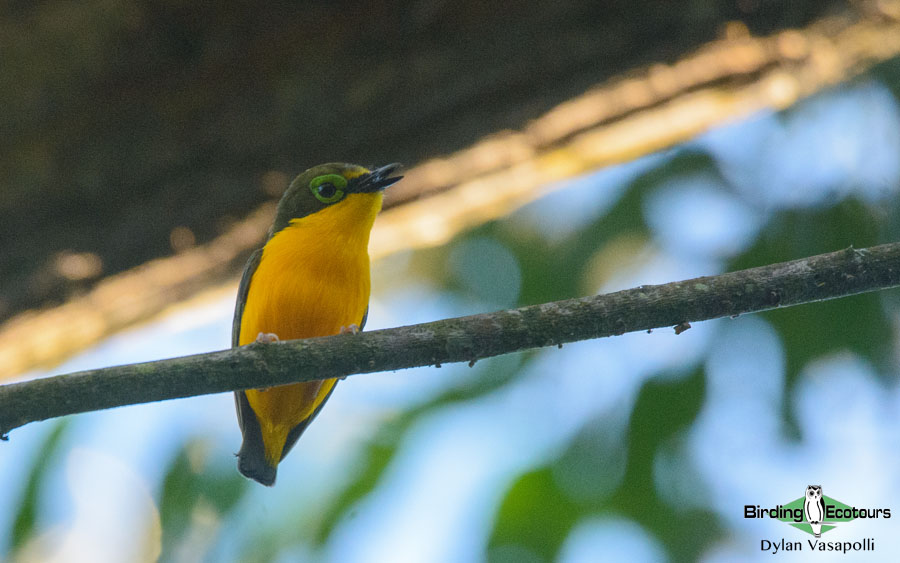
Day 13. Transfer from Kumbira Forest to Mount Moco
After two great days birding around Kumbira Forest we’ll get going early in the day to maximize our time around Mount Moco, the highest mountain in Angola. True to form, the drive will take us a while, and we anticipate arriving in the early afternoon. The habitat is extremely varied at Mount Moco, and the lower slopes see us transiting through grassy floodplains and fragmented miombo woodland patches before reaching a montane grassland plateau that then takes us to the actual base of the massif proper. We will likely concentrate our efforts this afternoon on the lower slopes, exploring the rank, grassy floodplains/depressions and miombo woodland patches. The area will likely be quite dry at this time of year, and we don’t expect much water to be around. Our main targets here will be the poorly known Brazza’s Martin and the incredibly localized Bocage’s Sunbird and Bocage’s Weaver. We will also search these areas for other sought-after species like Black-collared Bulbul, Marsh Widowbird, and the scarce Dusky Twinspot, while other species possible here include the likes of Coppery-tailed Coucal, Little Bee-eater, Croaking Cisticola, Fan-tailed Grassbird, Hartlaub’s Babbler, Sooty Chat, Brown Firefinch, Fawn-breasted and Orange-breasted Waxbills, and Fülleborn’s Longclaw. Venturing into the miombo, we will need to keep an ear open for the excited calls heralding the arrival of a bird party, and the stunted and fragmented woodland available here make this a bit easier, as we don’t have massive areas to explore. The birding can be incredibly exciting, and regular party members include Yellow-fronted Tinkerbird, Cardinal Woodpecker, Chinspot Batis, Brubru, White-crested Helmetshrike, Black Cuckooshrike, Green-capped Eremomela, Amethyst Sunbird, Yellow-throated Petronia, Red-headed Weaver, and Golden-breasted Bunting. As we follow these parties through the woodland we’ll also be searching for more specials, such as Anchieta’s Barbet, White-tailed Blue Flycatcher, Red-capped Crombec, Miombo Wren-Warbler, Rufous-bellied Tit, Salvadori’s and the spectacular Black-necked Eremomelas, Yellow-bellied Hyliota, African Spotted Creeper, Miombo Scrub Robin, Miombo Rock Thrush, Anchieta’s and Western Violet-backed Sunbirds, Orange-winged Pytilia, Broad-tailed Paradise Whydah, and Wood Pipit. Come evening we’ll transfer to Huambo, where we’ll spend the night.
Overnight: Huambo
Day 14. Birding Mount Moco and surroundings
Looking forward to a full day of birding, we’ll make an early start to Mount Moco, bound for the small, relict patches of montane forest at the top of the mountain. Once we reach the village of Kanjonde right at the base of the massif we’ll begin the walk up to the top, where the main forest lies. Please note that this is a very challenging hike over difficult, rocky terrain (not level pathways), including navigating steep slopes to get to the edge of the forest, and only those who are fit will be able to complete this arduous hike. Once we have made our way to the main forest patch our effort will be rewarded, as a host of exciting species awaits. The forest edge is one of the best places to track down the rare and localized endemic Swierstra’s Francolin, although seeing this bird remains a difficult challenge. Within the forest itself, though, we’ll be targeting chiefly the scarce Margaret’s Batis, here at its type locality, along with Western Tinkerbird, Black-backed Barbet, Evergreen Forest Warbler, African Hill Babbler, Grey Apalis, Bocage’s Akalat, the rare and localized Black-chinned Weaver, the poorly known Dusky Twinspot, and the endemic Angolan Slaty Flycatcher and Angolan Waxbill. Other possible species here include Schalow’s Turaco, Olive Woodpecker, Red-throated Wryneck, Cabanis’s Greenbul, African Yellow Warbler, Bronzy Sunbird, Dusky Indigobird, Brimstone and Yellow-crowned Canaries, and the curious local population of Thick-billed Seedeater.
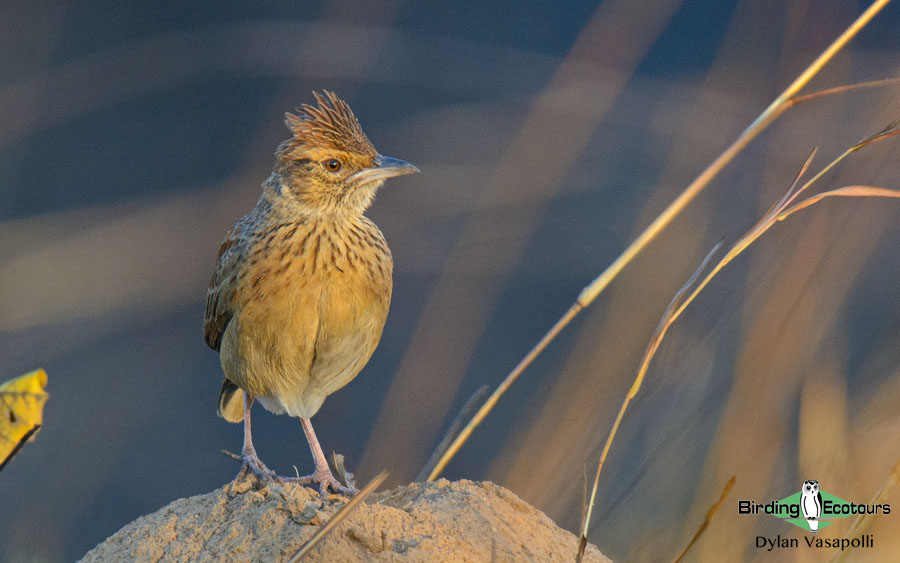
Moving away from the forest, the rocky slopes of the mountain host interesting species such as Wailing Cisticola, Mountain Wheatear, Striped and Long-billed Pipits, Cinnamon-breasted Bunting, and another curious local population, this time of Rock-loving Cisticola, which is believed by many authorities to be a separate species, Huambo Cisticola. The proteas here and other flowering plants host Oustalet’s and the endemic Ludwig’s Double-collared Sunbirds, while we must also keep an eye overhead for the likes of Augur and Red-necked Buzzards, Rock Kestrel, and Lanner Falcon, all of which frequent the area, along with the poorly known Fernando Po Swift. Gradually we’ll begin descending the mountain, eventually arriving back to Kanjonde, where we’ll take a break before resuming our birding in the afternoon. For those who are unable to complete the full hike up to the main forest patch there are several small patches on the lower slopes of the mountain, not far from the village, where some of the species mentioned above can be found, such as Western Tinkerbird, Grey Apalis, Bocage’s Akalat, Dusky Twinspot, Angolan Waxbill, and Schalow’s Turaco. We’ll explore the montane grasslands lining the plateau once we clear the miombo woodland for the afternoon, searching here for species such as Finsch’s Francolin, the near-endemic Angolan Lark, and the stunning Black-and-rufous Swallow. Although vocal, the francolins remain as difficult to see as ever, while the lark with its fascinating song is usually more confiding and the swallows race up and down the valleys among more common cousins, including Grey-rumped, Lesser Striped, and Greater Striped Swallows. Burns in this area attract Capped Wheatears along with good numbers of Red-capped Larks and Plain-backed Pipits, while African Marsh Harrier is a frequent sight above the grasslands.
Overnight: Huambo
Day 15. Transfer from Mount Moco to Benguela
We have the morning available to explore the lower slopes of Mount Moco, searching for any species that we may have missed, primarily within the miombo woodland or the rank, grassy depressions. Our drive today is quite a bit shorter than the last few we have undertaken, and our afternoon will be spent exploring the salt pans and lagoons around the coastal towns of Lobito and Benguela for a host of waterbirds. One of our primary targets here will be the sought-after Chestnut-banded Plover, while a good supporting cast of species will likely include Cape Teal, Black-necked Grebe, Greater and Lesser Flamingos, African Spoonbill, Great White Pelican, Reed, White-breasted, and Cape Cormorants, various other waders/shorebirds such as Black-winged Stilt, Pied Avocet, White-fronted and Kittlitz’s Plovers, Whimbrel, and Common Greenshank, along with Kelp Gull and a host of Terns, including Caspian, Sandwich and Royal.
Overnight: Benguela
Day 16. Transfer from Benguela to Lubango
We will have an early start heading into the hills near Benguela, where we will get our first taste of the true ‘Namibian’ specials. The dry, rocky acacia habitat along with the barren Namib Desert are core Namibian habitats, and both follow the coastal plain and reach their northernmost point here. Our morning will see us focus on the dry, rocky acacia habitat. One of the primary targets here is the reclusive Hartlaub’s Spurfowl. This small gamebird frequents rocky hillsides, where their loud, duetting call rings out from all parts of the hills and persistent scanning of exposed rocks is usually rewarded. We will also explore some of the drier, acacia-lined riverbeds, which host our remaining targets. The larger trees play host to Rüppell’s Parrot, Rosy-faced Lovebird, Carp’s Tit, and Bare-cheeked Babbler, while the denser areas of bush within the riverbeds host Pearl-spotted Owlet, Pale-olive Greenbul, Swamp Boubou, and Rufous-tailed Palm Thrush. Grey Go-away-birds perch conspicuously, while noisy Damara Red-billed and Southern Yellow-billed Hornbills are never far from sight.
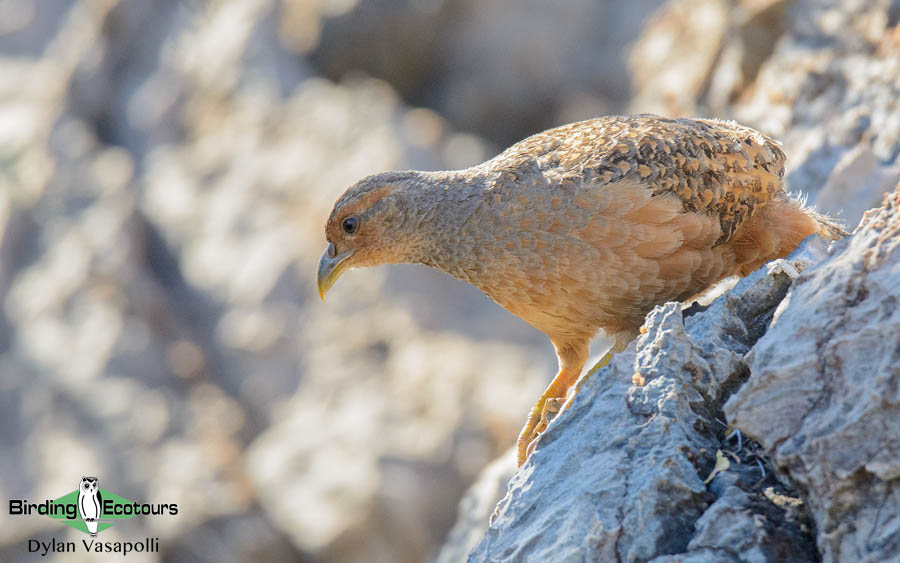
The surroundings are covered by typical dry acacia thornveld, which hosts a number of species including Acacia Pied Barbet, Pririt Batis, Bokmakierie, Brown-crowned Tchagra, African Red-eyed Bulbul, Long-billed Crombec, Cape Penduline Tit, Black-chested Prinia, Barred Wren-Warbler, Cape Starling, White-browed Scrub Robin, Red-billed Buffalo Weaver, White-browed Sparrow-Weaver, Green-winged Pytilia, Red-headed Finch, and Blue and Violet-eared Waxbills. Areas of open ground host Namaqua Dove and the stunning and unique White-tailed Shrike, and watching the latter ‘giant batises’ never fails to impress! We will also search overhead for Verreaux’s and Booted Eagles and Bateleur, while both Mottled and Böhm’s Spinetails frequent the skies above baobab trees. If we’re lucky, we may even find scarcer species such as Orange River Francolin in the area. We will eventually have to tear ourselves away from the fine birding here, as we transfer to the large city of Lubango. This is a long drive, and we will likely arrive in the late afternoon, from where we will check into our comfortable lodge.
Overnight: Casper Lodge, Lubango
Days 17 – 18. Birding Tundavala and Namibe
We have two full days to bird in the area. Our first day will be dedicated to birding the Tundavala Gap and the surrounding escarpment, located just outside Lubango. Another of Angola’s more famous natural sites, the Tundavala Gap affords spectacular views over the escarpment as it rapidly drops from the high plateau down to the coastal plain, more than 1000m below. While the core habitat up here is rocky grasslands, the valleys and gullies contain some forest-type habitat and the lower slopes just above Lubango town contain an interesting scrubby-woodland habitat. Working our way up from the bottom, the scrubby habitat is arguably the least interesting, even though it does hold many interesting species like Red-backed Mousebird, Yellow-fronted Tinkerbird, Bennett’s Woodpecker, Rattling and Tinkling Cisticolas, Hartlaub’s Babbler, Miombo Rock Thrush, a host of Sunbirds including Ludwig’s Double-collared and Oustalet’s, and various seedeaters such as Blue, Violet-eared, and the endemic Angolan Waxbills as well as Brimstone Canary. The grasslands too don’t have much interest, although top of the list here goes to the scarce Finsch’s Francolin, while other species to be sought include Red-capped Lark, Wing-snapping Cisticola, Buffy Pipit, and Quailfinch.
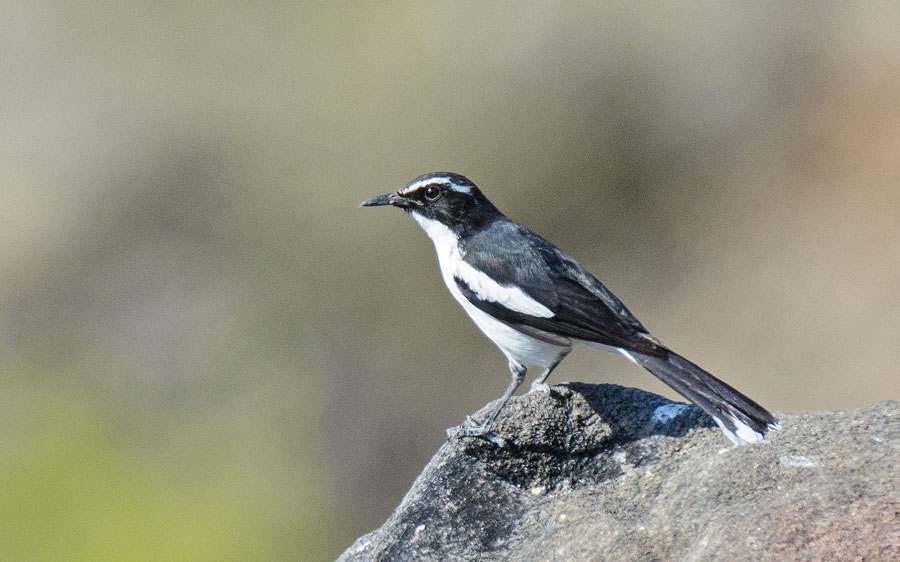
Once at the top, the various valleys and gullies and even the sheer escarpment drop-off itself host the area’s most exciting birds. While taking in the spectacular views of the Tundavala Gap we have a chance for several aerial species, of which Bradfield’s Swift should form the bulk of the numbers. Alpine Swift, Rock Martin, and Black Saw-wing should also feature, and we will keep an eye out for raptors, including Augur Buzzard, Rock Kestrel, and Booted Eagle. The open rocky areas are home to Short-toed Rock Thrush and Striped Pipit along with two of the main specials here, Rockrunner and Angolan Cave Chat. The latter two species typically require some work to track down as they slink through gaps in the rocks, and we will be sure to put in some time to track them down. The rare Swierstra’s Francolin occurs in these areas as well and will be another key target, should we have missed this bird earlier at Mount Moco. Where the forest-type habitat begins we’ll be on the lookout for Grey Apalis, Angolan Slaty Flycatcher, Ludwig’s Double-collared Sunbird, and Angolan Waxbill, while species such as Western Tinkerbird and even Bocage’s Akalat are possible as well.
For our second full day we will transfer down the escarpment to the dry coastal plain via the incredible Leba Pass. We will likely have a few birding stops as we descend this well-constructed and stunningly scenic pass, with the slopes featuring a forest-type zone. While we should have seen most of the possible species here on the tour already, we do have further chances for birds such as Schalow’s Turaco, Angolan Batis, African Golden Oriole, Grey-backed Camaroptera, Ashy Flycatcher, and the near-endemic Pale-olive Greenbul, among others. Our main birding, however, will only start once we have descended to the plains below, from where we will initially explore some of the dry, deciduous woodland, riverbeds, and acacia thornveld. Although a similar suite of species to what we sought around Benguela is possible here as well, arguably our biggest target is the localized and somewhat nomadic Cinderella Waxbill.
Other specials to be searched for here are Rüppell’s Parrot, Monteiro’s Hornbill, White-tailed Shrike, Carp’s Tit, Meves’s Starling, and Chestnut Weaver. While searching for these birds we’re also likely to come across the many other species occurring in the area, including Emerald-spotted Wood Dove, Grey Go-away-bird, Red-faced Mousebird, Black-collared Barbet, Golden-tailed Woodpecker, White-crested Helmetshrike, Black-headed Oriole, African Red-eyed Bulbul, Yellow-breasted Apalis, Cape and Violet-backed Starlings, Yellow-billed Oxpecker (on local cattle), Groundscraper Thrush, and Long-tailed Paradise Whydah. Transferring further west toward the coast the habitat rapidly changes and becomes increasingly drier. Stands of acacia thornveld in these dry zones host many species more characteristic of further south, such as Common Scimitarbill, Pririt Batis, Crimson-breasted Shrike, Bokmakierie, Ashy Tit, Cape Penduline Tit, Black-chested Prinia, Barred Wren-Warbler, Chestnut-vented Warbler, Yellow-bellied Eremomela, Kalahari Scrub Robin, White-bellied and Dusky Sunbirds, Scaly-feathered Weaver, Red-headed Finch, and White-throated and Yellow Canaries.
Continuing further we enter into the barren Namib Desert, and the dry gravel plains here host another suite of exciting species. The stately Ludwig’s Bustard and the sought-after Rüppell’s Korhaan stride through the open plains, while we will need to put in a concerted effort to track down the nomadic Namaqua Sandgrouse. Walking through the plains is also the best way to find the many lark species occurring here, of which we’ll be searching for Stark’s and Benguela Long-billed Larks along with more widespread species such as Spike-heeled Lark and Grey-backed Sparrow-Lark. Not to be outdone is the ghostly white Tractrac Chat, its close cousin, Karoo Chat, and the puzzling Chat Flycatcher. Lark-like Bunting can be present in large numbers, while we’ll need to keep an eye out for Pale-winged Starling as they roam the plains. Pale Chanting Goshawk is often easily seen perched atop roadside poles, as is the western race of Southern Fiscal. The coast at Namibe will be our end-point, from where we’ll retrace our steps back to Lubango after a great day trip and settle in for our last group dinner.
Overnight: Casper Lodge, Lubango
Day 19. Departure from Lubango
Today is our departure day, and the tour concludes after breakfast with a transfer to the airport in Lubango, from where we’ll fly back home.
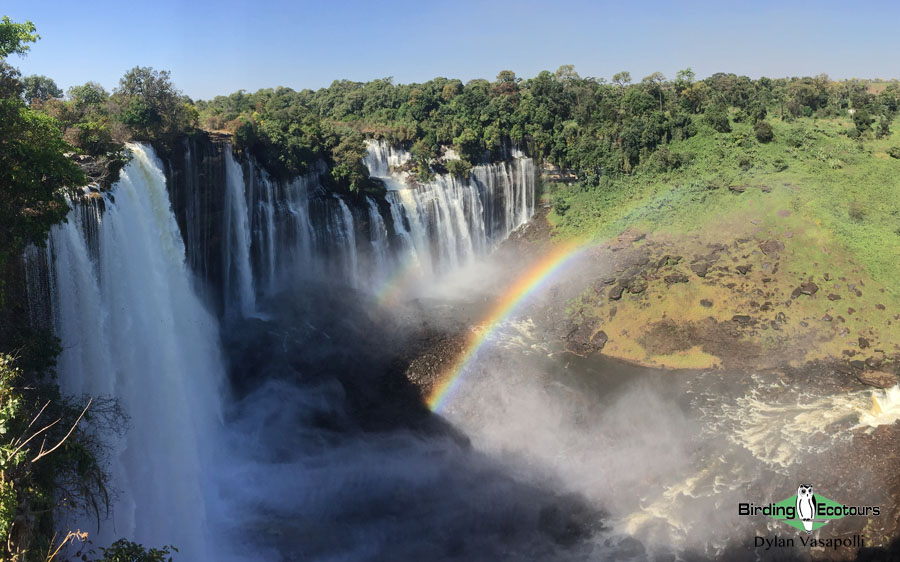
Please note that the itinerary cannot be guaranteed as it is only a rough guide and can be changed (usually slightly) due to factors such as availability of accommodation, updated information on the state of accommodation, roads, or birding sites, the discretion of the guides and other factors. In addition, we sometimes have to use a different international guide from the one advertised due to tour scheduling.
Download ItineraryANGOLA: AFRICA’S BEST-KEPT BIRDING SECRET
SET DEPARTURE TOUR REPORT
15 JUNE – 3 JULY 2022
By Dylan Vasapoli
DOWNLOAD TRIP REPORT
Overview
This 19-day set departure tour covers the core birding area in the country, focusing on the escarpment that runs north/south through the western half of the country. This area is prioritized on birding tours, as it houses all the country’s endemics and near-endemics, and also supports suitable infrastructure that make an all-accommodated tour without camping possible. This was Birding Ecotours’ first set departure birding tour to Angola, following a scouting trip in 2018, and it was great to be able to run our first proper tour here after having it postponed for several years due to the Covid-19 pandemic.
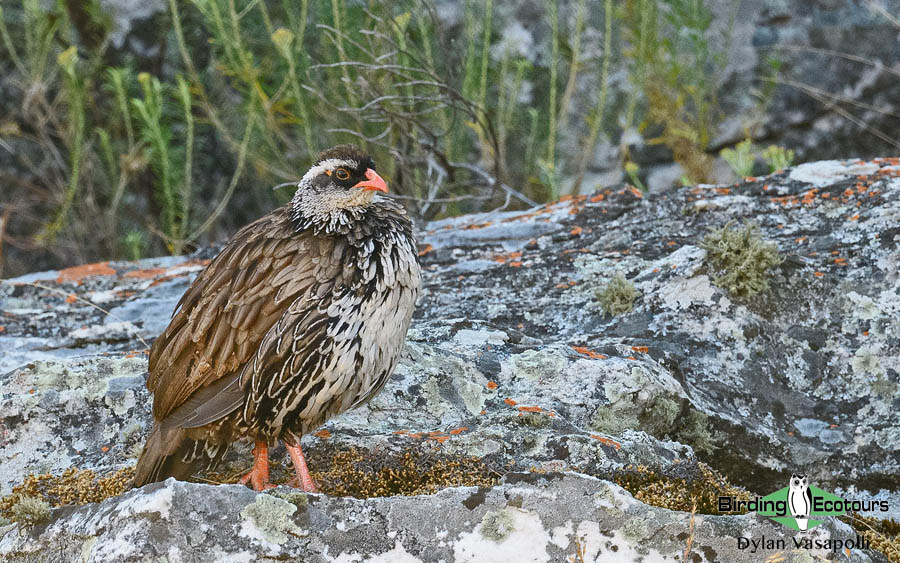
Despite this tour taking place towards the end of the worldwide Covid-19 pandemic, travel throughout the country was largely smooth, with no Covid-related issues to speak of. Logistics were also generally smooth, though as to be expected with travel in any rural third-world country, occasional delays and long transfers are inevitable with bad and poorly maintained roads the core problems. Fuel shortages experienced in the northern half of the country were managed as best as possible, and fortunately didn’t impede any of the birding, and the weather was generally very pleasant, again not impeding any birding.
This tour was focused on getting the various endemics, near-endemics and other highly prized birds that can be found within the country, and priority was given to these species – with the tour group not focusing on the more common and widespread species that can be found elsewhere. As such, this tour was not aimed at getting a high trip total, with various water-birding stops often overlooked, and many of the more widespread and common species missed on the tour.
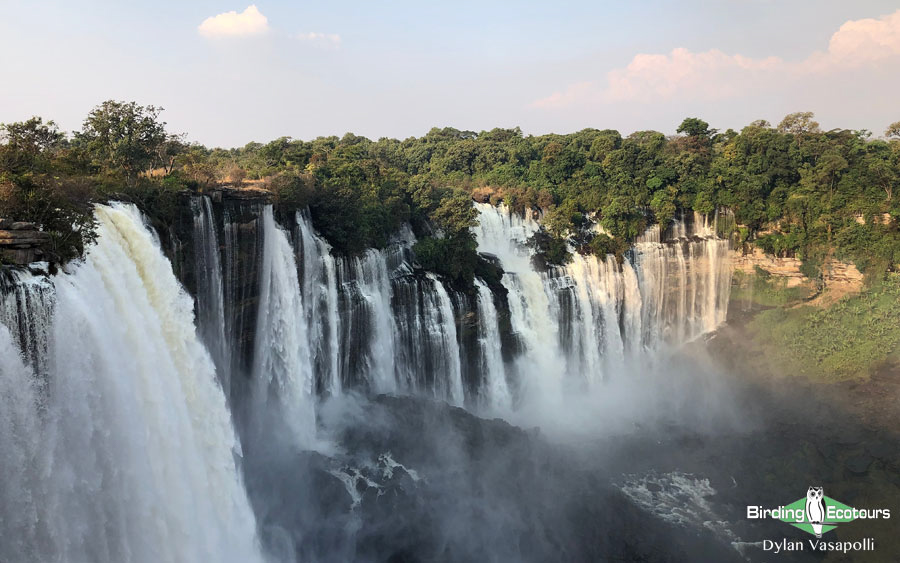
We started the trip in Luanda, the giant Angolan capital city, before we made our way to the Muxima woodlands for our first dose of endemic birding. This venue yielded the shy Grey-striped Spurfowl and the rare Gabela Helmetshrike, along with White-fronted Wattle-eye and Monteiro’s Bushshrikes as the other endemics seen. Journeying up to the northern scarp forests followed. Here we found the rare Braun’s Bushshrike, along with a host of equatorial species such as Black Bee-eater and Great Blue Turaco, alongside other specials such as Yellow-throated Nicator, Falkenstein’s Greenbul, and the local Black-collared Bulbul. The Kalandula region followed, delivering unexpected birds such as Angolan Lark and Marsh Widowbird, along with expected specialties like the mega White-headed Robin-Chat through to the endemic Red-crested Turaco – Angola’s national bird. Other exciting birds seen here included White-spotted Flufftail, Anchieta’s Barbet, Ross’s Turaco, African Broadbill, Red-throated Cliff Swallow, Bates’s and Bannerman’s Sunbirds and Sharp-tailed Starling. Naturally, we ensured we visited the spectacular Kalandula Falls as well. The birdy Tombingo Forests produced the likes of Red-fronted Parrot, Bristle-nosed Barbet and Red-rumped Tinkerbird amongst others, before an opportunistic stop en-route to Conda, yielded an incredible Egyptian Plover!
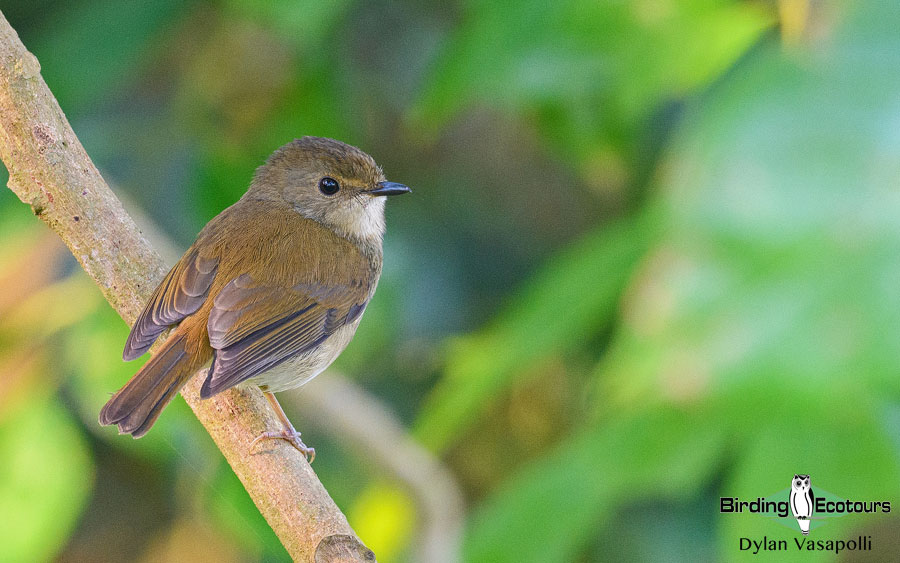
Conda, and the nearby Kumbira Forest followed, where we tracked down yet more endemics and specialties in the sadly quickly-disappeared forest. Top birds here went to Gabela Bushshrike, Gabela Akalat, Pulitzer’s Longbill and Red-crested Turaco, while other exciting species included Yellow-bellied Wattle-eye and the local endemic race of Naked-faced Barbet (known as Pale-throated Barbet). The Mount Moco region was next up, and produced some excellent birds. The montane areas held the likes of Swierstra’s Spurfowl, Angolan Waxbill, Ludwig’s Double-collared Sunbird and the unique race of Rock-loving Cisticola (known as Huambo Cisticola) amongst others. The miombo woodlands and floodplains on the lower slopes gave up a variety of birds from White-breasted Cuckooshrike, Red-capped Crombec, Yellow-bellied Hyliota to Black-and-rufous Swallow and Bocage’s Sunbird. The Benguela area produced the first of the more typical Namibia specials, with the likes of Hartlaub’s Spurfowl and Rockrunner showing along with many others, before we moved onto the Lubango area. The Tundavala Mountains were excellent, producing our final endemic, Angolan Slaty Flycatcher, along with other species such as Angolan Cave Chat, Bocage’s Akalat, and repeat views of the rare Swierstra’s Spurfowl. Our final day was spent birding a transect of habitats towards the coast of Namibe, and yielded more exciting birds including Rüppell’s Korhaan, Benguela Long-billed Lark, Monteiro’s Hornbill and a great many others. The trip ended in the southern city of Lubango.
The trip bird list just exceeded 400 species in total, with slightly fewer than this being seen as there were a handful of “heard only” species. The mammal count for the trip was low as expected. The full trip lists can be found at the end of this report.
Detailed Report
Day 1, 15th June. Arrival in Luanda, and birding the Kwanza River
Today was the arrival day, with the morning spent collecting guests as they arrived in Luanda and transferring to the Kwanza Lodge, scenically set on the banks of the Kwanza River south of the city. We were able to take a late afternoon walk around the area and managed to familiarize ourselves with some of the more widespread birds. Open areas held two exciting birds – both near-endemic – Red-backed Mousebird and Bubbling Cisticola, along with others such as Little Bee-eater and Blue Waxbill. Blue-breasted Kingfisher played hide and seek with us, calling from deep within the mangroves but remaining unseen, while various waterbirds moved about including Cape Cormorant and African Fish Eagle. Flocks of feral, and noisy, Rosy-faced Lovebird settled down for the evening and brought our first day to a close.
Day 2, 16th June. Birding the Kwanza and Muxima woodlands
We began our day off with a morning walk around the area. Our main target was the tricky Mangrove Sunbird, and while it took a bit of effort to track down, we enjoyed some good and close up views of this bird, as it busily moved about. Various waterbirds were once again quite active, and we added the likes of African Sacred Ibis, White-breasted Cormorant and Great Egret, amongst others. A flock of Mottled Swifts moved about overhead, while both Striped and Woodland Kingfishers showed well virtually side-by-side. Blue-breasted Kingfisher refused to show itself once more. Various other birds such as Palm-nut Vulture, Cardinal Woodpecker, Swamp Boubou, Rufous-vented Paradise Flycatcher and attractive Green-headed and Purple-banded Sunbirds were all evident. Following a good breakfast, we gathered our things and set off to the Muxima woodlands, set in the southern corner of the Kissama National Park.
A number of Angola’s endemics can be sought in these dry woodlands, and indeed it is actually the best locality to find some of these birds, and is a vital stop for any birding tour. Our late morning arrival meant we still had some time to enjoy the birding before it started tailing off, and indeed, we had barely begun our session when we ran into a bird party. Near-endemic Pale-olive Greenbuls snuck around the thickets, and showed well after some work, while a noisy group of White-crested Helmetshrikes floated by. Both Black-headed and African Golden Orioles were present, as was a pair of vocal Black Scimitarbills. Things started hotting up once more whilst enjoying another of the near-endemics, Hartert’s Camaroptera, when a flock of the rare and localized Gabela Helmetshrikes popped into view – our first true country endemic! We spent a short while with them, as they flopped around in their comical way, before a White-fronted Wattle-eye began to call – another endemic. Frustratingly, the bird only gave us brief views and left us wanting a bit more. Several of the peculiar Böhm’s Spinetail were also seen flying overhead before we had a break for lunch.
Our afternoon was a bit more leisurely, spent birding around the Kwanza River, well downstream of where we were this morning, however. Here we added a few more waterbirds, with the likes of White-faced Whistling Duck, African Jacana, Squacco Heron and Little Egret featuring. The very high level of the river meant there were no sandbars present, and one of our core targets here, Egyptian Plover, was not around. Nevertheless, we enjoyed a very productive first full day of birding.
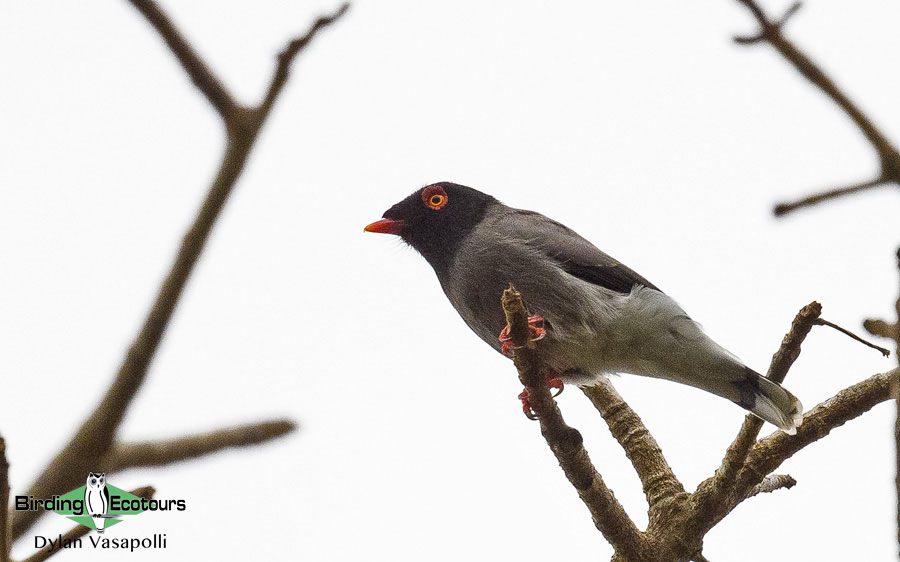
Day 3, 17th June. Birding the Muxima woodlands
With a few key targets still outstanding, we had an early start as we set off to bird the dry Muxima woodlands. Cool, overcast conditions kept bird activity high for the morning, and we did enjoy an excellent morning out. We got off to a flying start when our first stop produced the goods, delivering the shy endemic Grey-striped Spurfowl, which showed well, albeit briefly crossing the road. Thicker vegetation produced a lovely African Barred Owlet, with a mass-entourage of birds mobbing it including Green Wood Hoopoe, Brown-hooded Kingfisher, Black-backed Puffback, African Paradise Flycatcher, Scarlet-chested Sunbird, and best of all, another flock of the scarce Gabela Helmetshrikes! Forest Scrub Robin played hide and seek with us, with only some in the group managing views of this songster, before a Monteiro’s Bushshrike started calling – our last remaining endemic possible here. We set off in search of this bird, and after some careful positioning and some patience, we were rewarded with our first, albeit distant views. Bit by bit, our views got better and better, and we ended up enjoying excellent views of this stunning bird! Further birding yielded far better looks at White-fronted Wattle-eye than what we had managed the previous day – leaving us all feeling much better, along with netting other species such as Angolan Batis, Cardinal Woodpecker, Rufous-tailed Palm Thrush and Grey Waxbill. As the day began warming up, raptors became more obvious with the likes of African Harrier-Hawk, Brown Snake Eagle, Western Banded Snake Eagle, African Goshawk and Little Sparrowhawk all featuring. We also enjoyed views of Mottled Spinetail in between numerous Böhm’s Spinetails. Following a lunch break, we returned to our lodge where we had the afternoon at leisure, owing to our successful morning out.
Day 4, 18th June. Muxima to Uige
We had a long transfer today, making our way up to Uige, in the north of the country, where we would spend three nights, and have two full days to explore the mosaic of grasslands and equatorial scarp forests. The bulk of the day was spent driving, with little of interest seen along the way, but we did manage to get some birding in at the Damengola Forest in the late afternoon. The birding was extremely slow, however, and we struggled to eke out any birds, although picking up the likes of Naked-faced Barbet, Little Green Woodpecker, Banded Prinia and a lively flock of Rufous-crowned Eremomelas. While various other birds were heard calling, none cooperated. We called it time, and checked into our hotel in Uige, before settling down for the evening.
Day 5, 19th June. Birding the Damengola Forest
The main reason for venturing to this part of the country is to find the incredibly localized and rare endemic Braun’s Bushshrike. This area also hosts a range of more equatorial West African species that creep into this far northern bit of Angola. Overcast conditions with some mist and light drizzle greeted us on our arrival into the forest, which was alive with bird song. In no time, we had latched onto a calling Braun’s Bushshrike, and before we knew it, we were enjoying sublime views of this bird as it gave out its deep ‘croaking’ call from right in front of us! We really could not have asked for better views of this scarce bird. We then started turning our attention to some of the many other birds present in the area. Guinea Turacos bounded from tree to tree, while both Piping and African Pied Hornbills moved to and from their feeding sites in the area. More forested area yielded the likes of Pink-footed Puffback, Black Cuckooshrike, African Blue Flycatcher, Green Crombec, Dusky-blue Flycatcher, Red-headed Malimbe and Grey-headed Nigrita, amongst others. The deep hooting of Gabon Coucal rang out from some of the forest-edge areas, and we spent a while trying to obtain views – with no less than five birds calling all around us – sadly without seeing any of them. The surrounds also produced sought-after Lowland Masked Apalis, Blue Malkoha, Chestnut Wattle-eye and the tiny Yellow-throated Nicator. Some of the more open areas gave up Brown Twinspot, though they were unseen by a few in the group. Exploring another forest patch generated a few of the stunning Black Bee-eaters – surely one of the most attractive birds anywhere – along with the giant Great Blue Turaco and some nesting Black-and-white Mannikins. Several calling Chocolate-backed Kingfishers frustratingly remained out of sight, despite our best efforts. The afternoon birding was very slow with little of interest being seen, aside from some showy Speckled Tinkerbirds, distant Blue-throated Rollers and a vocal Black-and-white Shrike-flycatcher. We returned to Uige in the late afternoon following an excellent first day in the scarp forests!
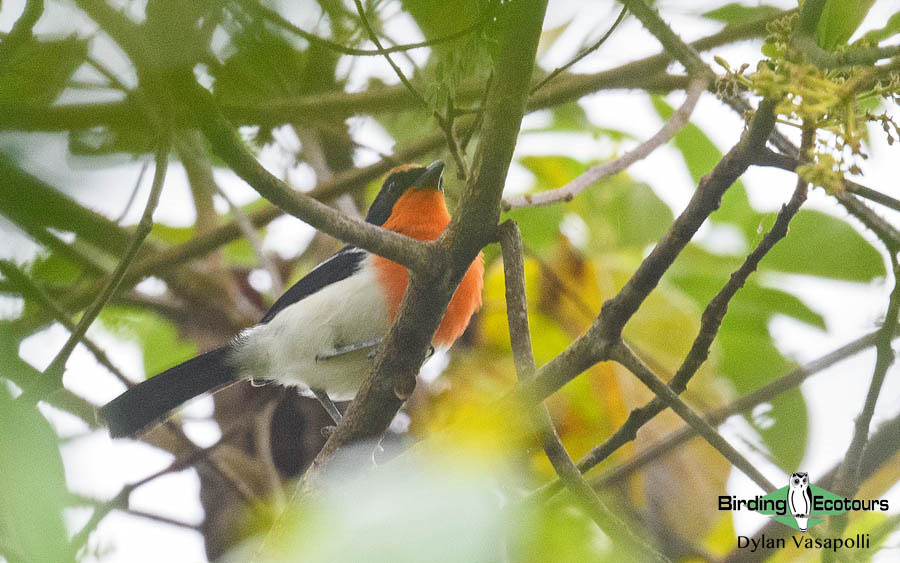
Day 6, 20th June. Birding the Damengola Forest
We had another day to explore the mighty scarp forests of the area trying to clean up on some of the many possible species that can be found here, with the added benefit of having already seen our main target, Braun’s Bushshrike, the previous day. We started off early in the forest, where we picked up species such as Hairy-breasted Barbet, Velvet-mantled Drongo, Blue-headed Crested Flycatcher, Falkenstein’s Greenbul, Buff-throated Apalis, Splendid Starling and Fraser’s Rufous Thrush amongst others, before venturing into the open grassy areas surrounding the forests. We spent the bulk of our morning birding these open areas, searching for our main target, the strange and localized Black-collared Bulbul. It took quite a bit of work, but we were eventually rewarded with great views of this highly sought-after bird, and in the process we added the likes of Brown-backed Scrub Robin, Compact Weaver, Black-winged Red Bishop, Orange-cheeked and Orange-breasted Waxbills and Brown Twinspot. We opted to head deeper into the forests, negotiating an ever-deteriorating road. While the birding did start to quieten down, we added the likes of Cassin’s Honeybird, Slender-billed Greenbul, Yellow-browed Camaroptera, Vieillot’s Black Weaver, Red-headed Malimbe and a plethora of sunbirds including Blue-throated Brown, Olive, Olive-bellied, Little Green, Grey-chinned and Collared Sunbirds. We did also enjoy some repeat views of various species such as Black Bee-eater, Blue-throated Roller and Braun’s Bushshrike, amongst others.

Day 7, 21st June. Uige to Kalandula, birding en-route
We left the exciting northern scarp forests behind, as we transferred southwards to the Kalandula area – home to arguably Angola’s most scenic attraction – the Kalandula Falls. Although the falls are incredible in their own right, the surrounding region plays host to a wide range of excellent birds. We made several stops along the journey with opportunistic grasslands stops producing fine Angolan Larks, Marsh Widowbirds and Fülleborn’s Longclaws, with other stops yielding Red-necked Buzzard, Retz’s Helmetshrikes, White-tailed Blue Flycatcher, Angolan Swallow, scarce Western Violet-backed Sunbird and Golden-breasted Bunting, amongst others. The road had unfortunately badly deteriorated, and took a long while to negotiate, but we eventually made our way through, and checked into our comfortable lodge on the outskirts of town, before heading off for our first dose of Kalandula birding. We arrived at the Kinjila Village, and immediately set off into the nearby swamp forests, which are home to the spectacular White-headed Robin-Chat – a species that was only fairly recently rediscovered, and is known only from a few localities! The forest was a bit quiet in the late afternoon, and while we heard White-headed Robin-Chat, we had to be content with no views – for now. A displaying African Broadbill caught our attention as well, and we enjoyed some excellent views of this sought-after bird as it displayed from an open branch right in front of us. Other species such as Cabanis’s Greenbul, Yellow-throated Leaflove and Dark-backed Weaver were added before we lost all light. We opted to stay on and try for a few nocturnal birds, and did well notching up African Scops Owl, while a brief Spotted Eagle Owl was seen on the way back – but sadly no nightjars were present.
Day 8, 22nd June. Birding Kinjila and surrounds
We had an early start once more, as we made our way to the Kinjila Village, where we met up with our excellent local guide, Joao, who would join us for the morning. We resumed where we had left off yesterday – by focusing on the mega White-headed Robin-Chat. About half of the group enjoyed good, albeit, brief views of this incredible bird early on in the day, but sadly the remainder of the group didn’t manage to get onto it. We spent a while trying for additional views, but the birds were extremely shy and refused to show. After discussing alternate plans, Joao, shepherded us off to another site, some distance away, where we would try again. The miombo along the way gave us our first views of the sought-after Sharp-tailed Starling along with Meyer’s Parrot and another Western Violet-backed Sunbird, while the grassy edges yielded a stunning pair of Brown Twinspots. Eventually, we arrived at the site, and in no time, had no less than three of the stunning White-headed Robin-Chats moving about around us, as they came to investigate these intruders. While the birds were again shy, and kept to the thickets, we enjoyed some fine views of these highly sought-after birds. A vocal White-spotted Flufftail was also seen moving through the leafy understory here.
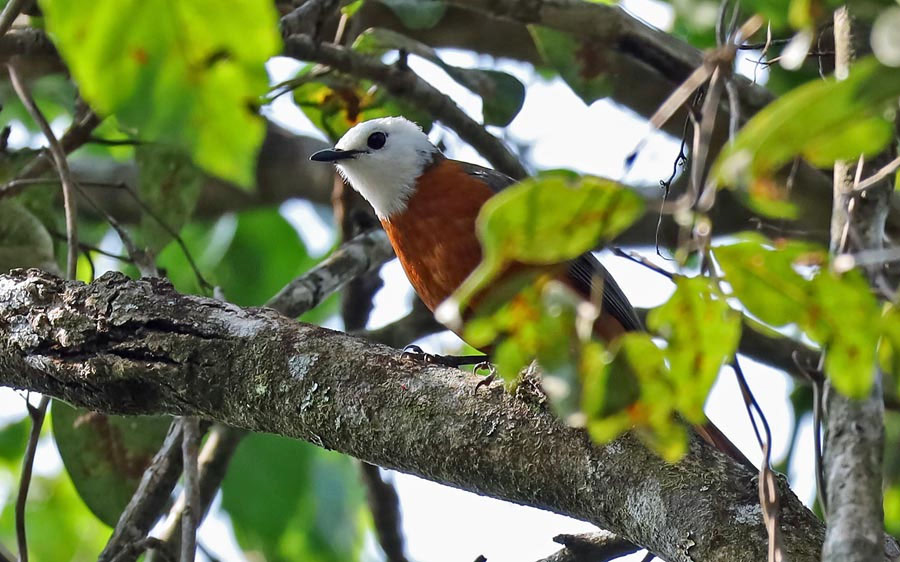
With massive smiles on our faces, we made our way back to the village and turned our attention onto some of the other birds that can be sought here. Red-crested Turaco, the national bird of Angola, was another major target, but sadly we had to be content with the birds calling around us from within the forest, with no views obtained despite much effort. Frustratingly, I was also the only person in the group to get onto the shy Grey-winged Robin-Chat. All too soon, our morning had come to a close, and we bid Joao farewell after a successful morning. Following a lunch-time break, we resumed birding the area ourselves, and stumbled into some flowering trees which were a hive of activity. Time here produced some excellent birds, with both scarce Bates’s and Bannerman’s Sunbirds showing well, while also yielding Black-throated Wattle-eye. A stop at the nearby Lucala River upstream of the falls produced a fine Greater Swamp Warbler, before we called in at the Kalandula Waterfalls to admire this immense natural attraction. While taking in this spectacular sight, we also notched up a Peregrine Falcon working the area. Following dinner, we set off to try our luck at a few night birds once more, but had to make do with a bird-less evening.
Day 9, 23rd June. Birding Kinjila and transfer to N’dalatando
While we had to transit to our next destination, at N’dalatando, the drive is a short one, and meant we had the full morning available to spend birding around Kinjila village, before setting off. We had an early start once more, starting our birding off in the miombo surrounding the village. As miombo birding can go, it was surprisingly quiet with little activity. Flocks of Sharp-tailed Starling moved about noisily overhead, as did a mixed flock of White-crested and Retz’s Helmethshrikes, with both White-breasted Cuckooshrike and Miombo Scrub Robin frustratingly remaining unseen. We also found a few of the scarce Orange-winged Pytilia feeding in the road. Following a quick bite to eat, we set off to explore another portion of the swamp forest and surrounds, and did well with a very showy pair of Ross’s Turaco (that we had only heard previously), while also notching up an unexpected pair of Red-headed Lovebirds and a Landana Firefinch. A quick jaunt into another section of miombo finally gave us Anchieta’s Barbet, though the bird didn’t hang around for very long, plus a large group of noisy Pale-billed Hornbills that put on a good show. Other species seen included Moustached Grass Warbler, Fawn-breasted Waxbill, Broad-tailed Paradise-Whydah and Cabanis’s Bunting, amongst others. With our time almost up, we opted to have one last go for Red-crested Turaco (Angola’s spectacular national bird!). After having spent much time over the last few days hearing various birds call, and not seeing any, we were elated when we obtained some views almost as soon as we stepped into their swamp forest habitat. Spending a bit more time in the area yielded more and better views – with what must have been around ten individuals bounding around in the treetops above us at one stage! Olive Long-tailed Cuckoo was heard calling from the area, but couldn’t be seen. A stop at the Lucala River on our way back finally produced the goods with a massive flock of Red-throated Cliff Swallows present.
We gathered our belongings, and following lunch, set off to N’dalatando. The bulk of the road was in good shape, and we made good time, with a quick stop along the Lucala River not producing anything of interest due to the high water levels. We checked in at our hotel in the mid-afternoon, before venturing off for the last bit of the afternoon to the nearby Tombingo Forest. We had a very birdy afternoon, with lots of birds present – enjoying the likes of colorful Klaas’s Cuckoo, noisy Honeyguide Greenbuls, drumming Yellow-crested Woodpeckers and a few of the strange Naked-faced Barbets. Eventually, after much searching, we also finally tracked down Red-rumped Tinkerbird – a species we had been looking for, while also enjoying repeat views of birds such as Fraser’s Rufous Thrush, Black-winged Oriole, Green Crombec, Ashy Flycatcher and White-breasted Nigrita. We settled in for the evening, following another successful day.
Day 10, 24th June. Birding Tombingo Forest, and transfer to Conda
Today was effectively another travel day, as we made our way further southwards, to the Conda area – home to the endemic-rich Kumbira Forest. However, we had a bit of time available in the morning, and were able to spend it at the excellent Tombingo Forest. We again had a great time in this birdy forest with the morning sky filled with numerous Piping and African Pied Hornbills along with noisy Red-fronted Parrots as they all commuted up and down. We were also eventually able to track down another of our outstanding forest birds – Bristle-nosed Barbet – as we found a large mixed flock of both this species and the similar Naked-faced Barbet moving about. The attractive Yellow-billed Barbet showed well, and was a hit with everyone, as was the incredibly colorful Purple-throated Cuckooshrike. We again had repeat views of various species such as Buff-throated Apalis, Green Hylia, Rufous-crowned Eremomela, Yellow-throated Nicator and Falkenstein’s Greenbul, while also adding the likes of Green-throated and Superb Sunbirds, amongst several other sunbird species. Eventually we had to tear ourselves away, and press onwards. Unfortunately, whilst trying to refuel in town, we learned that the area was entirely without diesel, leaving us in a bit of a pickle – but fortunately, our excellent local driver managed to secure some for us, allowing us to continue on our way following a bit of a wait. We eventually broke for our lunch along the way, and it proved to be very fortuitous, as an incredible Egyptian Plover patrolled the shoreline right in front of where we had stopped. With the high water levels in the country, we could scarcely believe our luck having given up on this bird, and enjoyed some great views of this highly prized species! The rest of the afternoon was spent in transit, as we made our way along the windy road to Conda, eventually arriving just before dark.
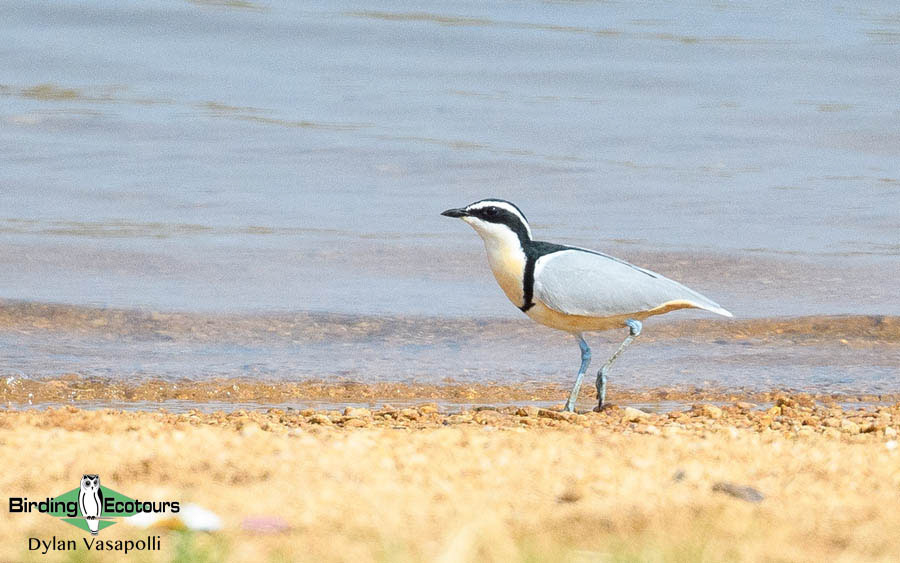
Day 11, 25th June. Birding Kumbira Forest
Kumbira Forest is one of the most important birding localities in Angola, hosting a number of Angolan endemics that are largely restricted to this central part of the escarpment, and not possible outside of this area. The forest, however, has been a major cause for concern with immense deforestation taking place, and this tour showed us that there were no signs of it easing up – urgent action is required.
We had given ourselves two full days in the area, which would hopefully be enough time to track down the many target species we had here. As we slowly made our way into the ‘forest’, which consists primarily of cleared and open bushy areas, with some larger trees lining the various water courses – we began working the area, stopping wherever there were bits of bird activity. We were off to a great start with early stops producing the first of our endemic targets – Gabela Akalat. This is a shy forest robin, and we were thrilled to enjoy excellent, and for an akalat, extremely prolonged views! We also got quickly acquainted with many of the more regularly-occurring birds of the area, some of which we had already seen on the tour – such as Crowned Hornbill, Yellow-rumped Tinkerbird, Little Green Woodpecker, Angolan Batis, African Blue Flycatcher, Falkenstein’s Greenbul and Buff-throated Apalis, amongst others. We also enjoyed several sightings of African Broadbill, before we heard the tell-tale calls of Gabela Bushshrike – arguably the most difficult-to-find endemic in the country (given the current status of this quickly-disappearing forest). The bird was well off in the distance, and we slowly set about making our way closer, and after a stiff uphill climb, found ourselves within arms-length of the bird. It took a nervous few moments before we all managed to get onto the bird, with only some in the group initially able to see it. As it turned out, we needn’t have worried, as we all enjoyed excellent looks at this highly sought-after species, leaving us all brimming from ear to ear! We also picked up on the local endemic subspecies of Naked-faced Barbet (known as Pale-throated Barbet – surely a split in waiting) nearby.
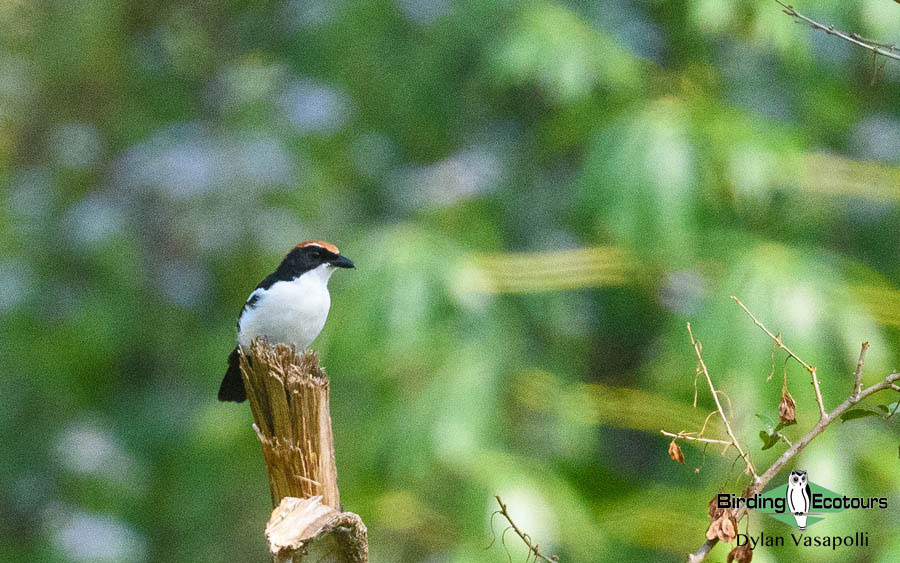
The remainder of our morning was excellent as well, with us enjoying a small feeding group of Red-crested Turacos – giving us some great views, along with the puzzling local race of Southern Hyliota (known as Forest Hyliota), Dusky Tit, Blue Malkoha and Yellow-throated Nicator. Another shy forest robin, Brown-chested Alethe, gave us extraordinary views, sitting motionless a short distance away, while a pair of colorful Yellow-bellied Wattle-eyes dazzled us with prolonged views. We had one last major target, the rare endemic, Pulitzer’s Longbill, and as if our already great day couldn’t get any better, we struck gold finding a pair of these strange birds on our way out of the forest. While they proved difficult to see well, keeping to the dark thickets and speedily hopping along, we were satisfied with our views, and called it a day with the remainder of the afternoon spent at leisure around our comfortable lodge.
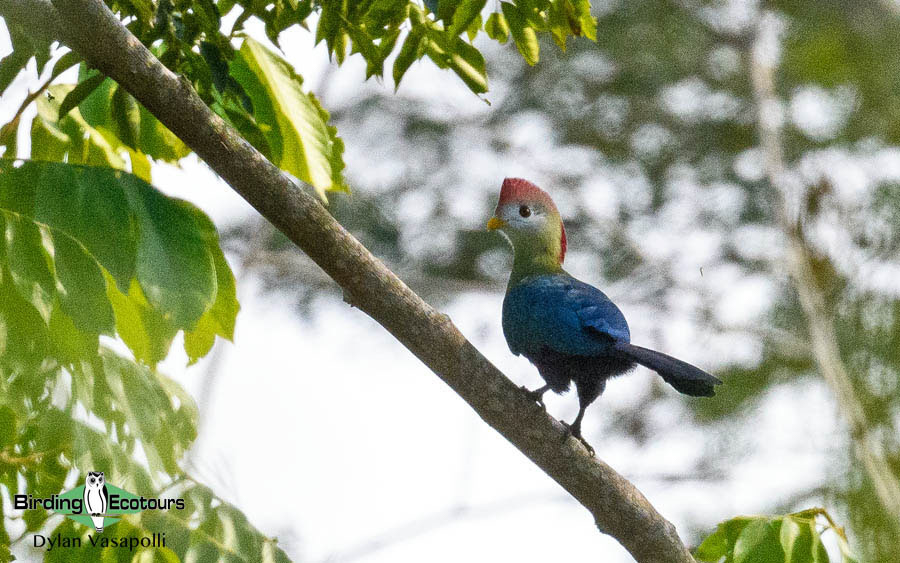
Day 12, 26th June. Birding Kumbira Forest
With the pressure effectively ‘off’, having bagged all our major targets, we spent the morning exploring a different part of the forest – which was sadly in even more dire straits with the deforestation. As a whole, the day was much slower than the previous day. We started off well nevertheless, with far better views of a pair of Pulitzer’s Longbills than we managed the previous day. A lovely Black-backed Barbet was another early highlight, as was a Forest Scrub Robin that played hide and seek with the group – showing extremely well to half the group, while remaining unseen by the other half. We also enjoyed repeat views of Red-crested Turaco, Yellow-bellied Wattle-eye, Falkenstein’s Greenbul and Brown Twinspot. Finding a pair of White-fronted Wattle-eyes, another of Angola’s endemic birds we had enjoyed earlier on the trip around Muxima, was a big surprise. Our afternoon was spent at leisure around the lodge.
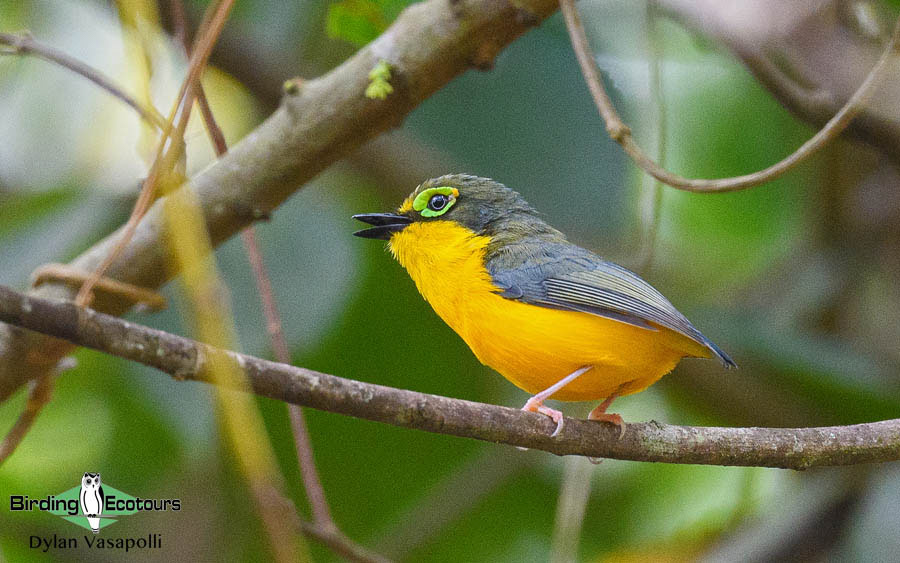
Day 13, 27th June. Conda to Mount Moco
An exciting few days lay ahead, as we moved away from the Kumbira Forest area towards Mount Moco – the highest mountain in Angola. We made good progress on the bad roads, with some stops on the way producing Sooty Chat and the highly sought-after Black-and-rufous Swallow, before we arrived into the greater Mount Moco area, concentrating on the more open lower slopes. Although it was warm and sunny out, we enjoyed a productive afternoon with our main highlight being a few of the highly sought-after Bocage’s Sunbirds showing well around some flowering plants. Careful watching here also produced the scarce Oustalet’s Sunbird amongst the more numerous Copper, Variable and Amethyst Sunbirds. Riverine trees produced a lovely Anchieta’s Barbet, that was sadly chased away very quickly by Black-collared Barbets, with the surrounding rank growth delivering Coppery-tailed Coucal, African Yellow Warbler, Short-winged Cisticola, Yellow Bishop and Fawn-breasted Waxbill. A pair of Fülleborn’s Longclaws showed in some of the floodplain areas, which were also a haven for swallows, with Grey-rumped, Pearl-breasted, Lesser Striped and repeat views of Black-and-rufous Swallows all showing well! We eventually had to pull ourselves away from the birding, and made the long journey to our lodge, not helped with the badly potholed road, where we arrived just before dark.
Day 14, 28th June. Birding Mount Moco IBA
One of the most anticipated days of the trip had arrived – our full day of exploring Mount Moco, with us also venturing onto the mountainous slopes in search of some of the montane specials, and the last remaining country endemics. We had an early start from our lodge, as we made the long journey to the mountain, eventually arriving at the Kanjonde village, where we arranged access to the forest on the lower slopes of the mountain. As a great change from the somewhat heart wrenching sight of the disappearing Kumbira Forest, this village has an active reforestation program where appropriate trees are planted in the area. We did not make the arduous hike up to the forest patch at the top of the mountain, but rather focused our efforts on the smaller fragmented patches on the lower slopes just above the village, and the core focal point of the reforestation project. The wind was intense during the morning, and meant we had a very quiet start to the day, with virtually no sight or sound of anything. The forest edge eventually yielded a pair of the local race of Rock-loving Cisticola, known as Huambo Cisticola which is a species in waiting and will be split off in due course, along with the first of our outstanding endemic birds – Ludwig’s Double-collared Sunbird. We also got onto some Grey Apalis and White-tailed Blue Flycatchers, before we picked up a stunning Western Tinkerbird that gave us excellent views! As we ventured further, exploring some of the more rank growth on the slopes, arguably our main target for this area, and another contender for Angola’s most difficult endemic, Swierstra’s Spurfowl, called, though remained firmly hidden in the dense undergrowth. We spent a long while working the bird, and eventually managed to get some good, albeit brief views, as the bird flushed from the undergrowth edge close to us. Not perhaps the greatest views of this scarce endemic, but we were elated to have set eyes on this difficult bird. Whilst waiting for the spurfowl, we did well notching up another endemic, Angolan Waxbill – which gave us incredibly close views, almost landing on top of us. Dusky Twinspots were not as cooperative, only giving us brief views. Other species seen included Horus Swift, Schalow’s Turaco, Olive Woodpecker, Black-throated Wattle-eye, Wailing Cisticola, African Dusky Flycatcher, Bronzy Sunbird, Dusky Indigobird and Yellow-crowned Canary.
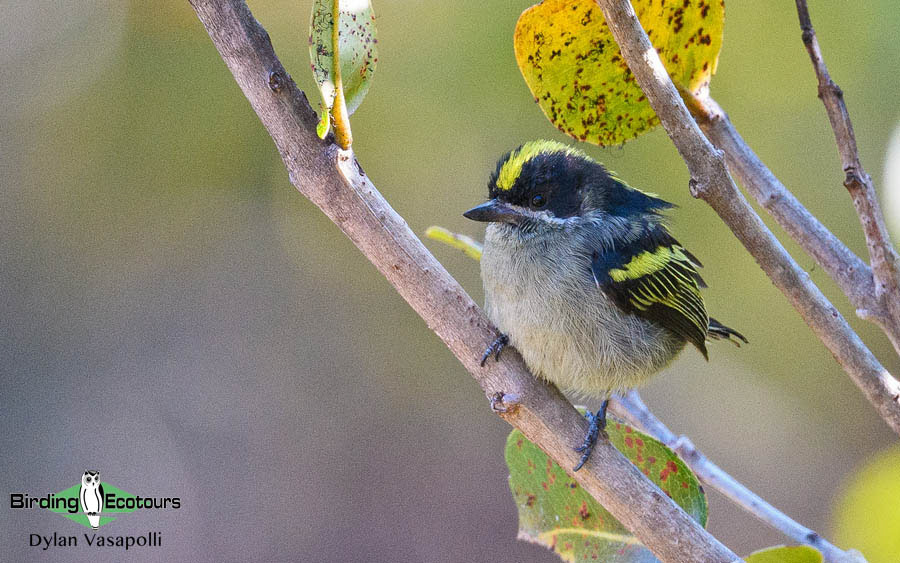
We eventually made our way back down from the forested areas, and headed into the miombo woodlands on the lower slopes of the mountain, where we would spend the afternoon. As it often goes in miombo woodland, which is very much bird-party dependent, the birding can be slow, and we had a fairly quiet afternoon, though with considerable effort we managed to eke out a few birds. Noisy and boisterous Green-capped Eremomelas were quite common, with us finding many different families, while a male Miombo Rock Thrush showed well, as did a fine Miombo Scrub Robin. A bit of activity late in the day gave up a few specials, with a bright Yellow-bellied Hyliota popping into view, before a drab Miombo Wren Warbler and a shy Red-capped Crombec showed as well. An unexpected Black-bellied Bustard was seen on our way out. Following an excellent, but long day out in the field, we returned to our lodge, and were greeted with an excellent Western Barn Owl sitting under the eaves, before we settled in for the evening.
Day 15, 29th June. Birding Mount Moco IBA, and transfer to Benguela
We had an early start once again, this time departing the lodge with all our belongings as we ultimately transferred to the coast, at Benguela, where we would spend the night. We had effectively the full morning available to us to bird the greater Mount Moco area, and opted to explore an interesting looking area, that would hopefully produce some miombo birds and some floodplain birds. The miombo was generally quite birdy, and we did well with a few bird parties yielding a lovely White-breasted Cuckooshrike, along with numerous Miombo Scrub Robins, Wood Pipits, Western Violet-backed Sunbirds, along with Dark Chanting Goshawk, a shy Green-backed Honeybird, Greater Honeyguide, Black-crowned Tchagra, Grey Penduline Tit, Red-capped Crombec, Yellow-bellied Hyliota and Yellow-throated Bush Sparrow. Once again, we found numerous Green-capped Eremomelas, and no matter how hard we tried, we just couldn’t seem to find any of the sought-after Black-necked Eremomela. A promising looking floodplain produced Black-and-rufous Swallows, along with other widespread species, plus Chirping Cisticola, Marsh Widowbird and Quailfinch, amongst others, but little else of interest. Following our lunch break, we began the journey to the coast, but a spate of bad luck hindered our progress – with two punctures along the way, and immense roadworks through Lobito which took the better part of 1.5 hours to navigate – and ultimately meant we needed to sacrifice our wetland birding, and we arrived after dark at our lovely coastal hotel near Benguela, where a wonderful seafood dinner settled us in for the night.
Day 16, 30th June. Benguela to Lubango, birding en-route
Today is largely set aside as a travel day, as we make our way to Lubango for the final few days of the tour – though with some obligatory stops along the way. We had a slightly easier-going morning, and started our day off with a quick coastal saltworks stop that produced Lesser Flamingo, a variety of shorebirds including Black-winged Stilt, Kittlitz’s Plover, Curlew Sandpiper and Common Greenshank, along with a gull/tern roost comprised of Kelp and Grey-headed Gulls and Caspian and Sandwich Terns. We then transited inland where we focused on some mountain birding, searching for some of the more typical Namibia specials. Core amongst these is the scarce Hartlaub’s Spurfowl, which showed remarkably well shortly after we arrived in the area. We then set about on a short walk, notching up delightful White-tailed Shrikes as they bounded across the plains, along with other specials such as Rüppell’s Parrot, Bare-cheeked Babbler and best of all, a lovely Rockrunner, perched up and singing away for us. Other birds seen here included Mottled Spinetail, tiny Pearl-spotted Owlet, Red-faced Mousebird, Common Scimitarbill, Acacia Pied Barbet, Pririt Batis, Southern White-crowned Shrike, White-browed Scrub Robin and White-throated Canary. A pair of Verreaux’s Eagles and an African Hawk Eagle graced the skies before we had to call time and continue on our journey. The road was slow going in places, and the Lubango traffic meant we finally arrived at our comfortable lodge in the late afternoon, and settled in for the last three nights of the trip.
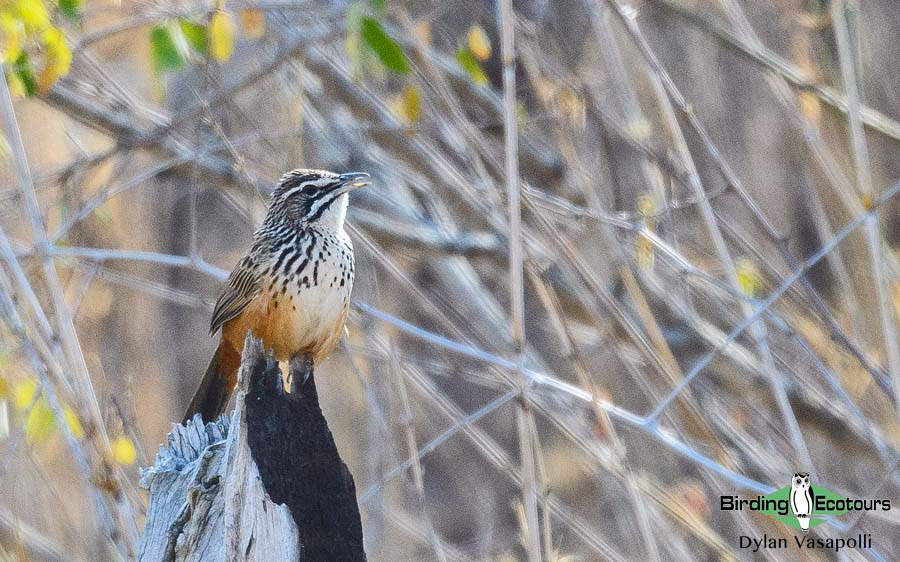
Day 17, 1st July. Birding Tundavala
Another exciting day awaited us, as we set off for the dramatic mountains of the Tundavala area, just outside of Lubango. Our birding began quietly as we sought out our last endemic, Angolan Slaty Flycatcher along with another major target, Angolan Cave Chat. A few Ludwig’s Double-collared Sunbirds were an early highlight, as was the active White-tailed Blue Flycatcher, before a bright Orange-breasted Bushshrike popped up, but our main targets were nowhere to be found. We pressed onwards, and struck gold, finding a stunning Angolan Cave Chat sitting up in the open for all of us to admire. The bird didn’t hang around for too long, before melting back into the rocks, but we had all enjoyed great looks! A number of raptors moved about overhead, with multiple Booted Eagles, Rock Kestrels and a Lanner Falcon all showing well, before we finally got onto our last endemic, an Angolan Slaty Flycatcher. The bird didn’t hang around long, and only some of the group managed to get onto it – so we worked the area for a little while longer. This proved to be a good move, as not long after, we could scarcely contain our excitement when we latched onto a Swierstra’s Spurfowl bounding over the rocks. With a little bit of patience, we were rewarded with sublime views of this difficult endemic, as the bird came out fully into the open and put on quite the show for us! We eventually had to pull ourselves away from this incredible sighting, as the Angolan Slaty Flycatcher had returned, and this time perched up allowing everyone to get great looks at our final Angolan endemic. We all breathed a heavy sigh of relief, and marveled at the extraordinary morning we’d had so far already! A quick coffee and biscuit break allowed us to reflect on the incredible sightings we’d had this morning, before we resumed exploring further areas. Short-toed Rock Thrush and Rockrunner showed well to us, before we focused on trying to get Bocage’s Akalat, which we had missed earlier on the trip. It took a bit of work, but we were well rewarded, with good looks at this stunning bird, along with repeat views of both Angolan Cave Chat and Angolan Slaty Flycatcher in the process as well.
We took a break over the midday period, returning to our lodge, before resuming later in the afternoon, this time exploring the lower slopes of the Tundavala area. We had a good afternoon, with the scrubby vegetation on the lower slopes yielding Violet-eared Waxbill, the local race of Jameson’s Firefinch (known as Ansorge’s Firefinch), Tinkling Cisticola, a calling Bokmakierie and a lone Salvadori’s Eremomela – another of the target birds we missed earlier on the trip. Some riverine vegetation gave up a pair of Lesser Swamp Warblers and Holub’s Golden Weavers, before rounding out the day with a scenic view of this stunning area. Following dinner, we ventured back up to the top, to try for some night birds, with a vocal Freckled Nightjar calling in the distance about the best we could manage. Regardless, we couldn’t have asked for a better day exploring the scenic Tundavala area.
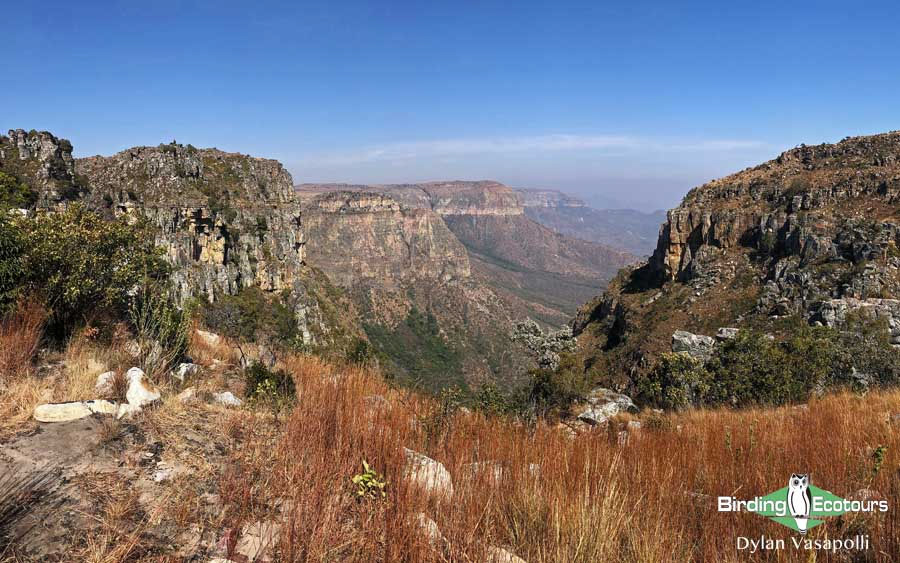
Day 18, 2nd July. Birding day trip to Namibe
This was our last full day birding of the trip, and we set off early bound for the Namibe region. This is a particularly interesting route, as the habitat becomes drier and drier the closer to the coast you get – with all the regions hosting a different set of birds. Once we had descended the scenic Leba Pass, we began our birding off by searching some of the riverine scrub and surrounds in the initial stages of the route for the tricky Cinderella Waxbill. Try as we might, we just couldn’t find any individuals, and would indeed miss this bird today. Aside from the waxbill, we enjoyed some excellent birding, adding a few more of the more typical Namibian specials such as Monteiro’s and Damara Red-billed Hornbills, Rosy-faced Lovebird (proper wild birds here, compared to the feral birds around the Kwanza River), and the local race of Meves’s Starling, while getting repeat views of other specials such as White-tailed Shrike and Rüppell’s Parrot. Other birds that kept us entertained included Red-necked Spurfowl, Grey Go-away-bird, Gabar Goshawk, Red-backed Mousebird, African Grey Hornbill, Swallow-tailed Bee-eater, Yellow-fronted Tinkerbird, Pririt Batis, Brown-crowned Tchagra, White-crested Helmetshrike, African Red-eyed Bulbul, Yellow-breasted Apalis, Yellow-billed Oxpecker, White-browed Sparrow-Weaver and White-bellied Sunbird. Our next stop was much closer to the coast, where we settled into the very dry and sparse Namib Desert plains. Following our lunch break, we set off, tracking down cute Spike-heeled Larks and delicate Tractrac Chats, along with finding other species such as Mountain Wheatear and the local race of pale Karoo Chats. Rüppell’s Korhaan took some work to track down, but after hearing several croaking away, we finally got some distant views, while several Benguela Long-billed Larks put on a great display for us. We also picked up the likes of Pale Chanting Goshawk, Pale-winged Starling and Chat Flycatcher as we worked the area.
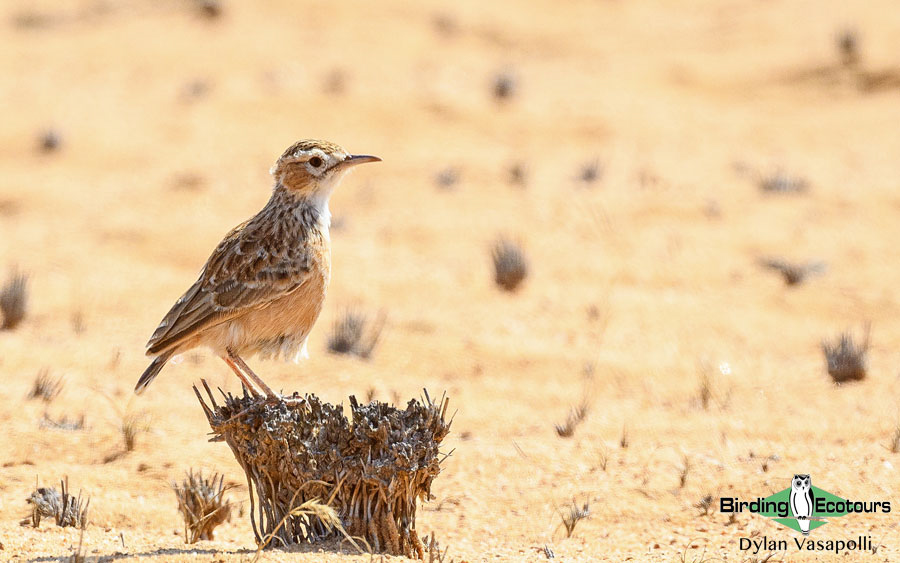
Our final birding stop of the day was in very dry thornveld habitat, where we had an incredibly birdy afternoon. A plethora of Scarlet-chested, Dusky and White-bellied Sunbirds were never far away, while tiny Pririt Batises bounded away in the bushes and delicate Kalahari Scrub Robins perched atop the bushes. The stunningly bright Crimson-breasted Shrike showed well, as did a confiding pair of Brubrus, while some careful searching yielded Barred Wren-Warbler and Yellow-bellied Eremomela. A number of other species we had seen earlier in the day were present as well, before we called it time, and made our way back to Lubango, pausing at the top of the Leba Pass to take in the incredibly scenic views of this area. This proved fruitful as it also yielded a surprise Carp’s Tit. We rounded off our final dinner reminiscing about the trip, and working through our main trip highlights.
Day 19, 3rd July. Departure from Lubango
With afternoon flight departures, the morning was spent at leisure around our lodge, with no formal plans. Following our final lunch together, we departed for the airport, where the tour came to a close.
I would like to thank all the participants who joined this set departure tour, for making it a good success. Likewise, thanks must also go to our excellent ground operators, all of whom made this the good success it was, with all of the country’s endemics, and almost all of the country’s main specials and near-endemics being found!
Without further ado, here are the tour favorites, as voted for by the group:
- Swierstra’s Spurfowl
- White-headed Robin-Chat
- Gabela Bushshrike
- Black-collared Bulbul
- Egyptian Plover
Honorable mentions go out to the likes of:
- Gabela Helmetshrike
- Bates’s Sunbird
- Yellow-bellied Wattle-eye
- Angola Cave Chat
- White-spotted Flufftail
- Schalow’s Turaco
- Monteiro’s Bushshrike
- Western Tinkerbird
- Landana Firefinch
- Purple-banded Sunbird
- Green-capped Eremomela
Bird List – Following IOC 12.1
Birds ‘heard only’ are marked with (H) after the common name, birds seen only by the guide are marked with a (G) after the common name, all other species were seen.
The following notation after species names is used to show conservation status following the IUCN Red List:
CR = Critically Endangered, EN = Endangered, VU = Vulnerable, NT = Near Threatened.
Angolan endemics are bolded.
| Common name | Scientific name |
| Ducks, Geese, Swans (Anatidae) | |
| White-faced Whistling Duck | Dendrocygna viduata |
| Guineafowl (Numididae) | |
| Helmeted Guineafowl | Numida meleagris |
| Pheasants & Allies (Phasianidae) | |
| Crested Francolin (H) | Ortygornis sephaena |
| Hartlaub’s Spurfowl | Pternistis hartlaubi |
| Swierstra’s Spurfowl – EN | Pternistis swierstrai |
| Grey-striped Spurfowl | Pternistis griseostriatus |
| Red-necked Spurfowl | Pternistis afer |
| Nightjars (Caprimulgidae) | |
| Freckled Nightjar (H) | Caprimulgus tristigma |
| Swifts (Apodidae) | |
| Mottled Spinetail | Telacanthura ussheri |
| Böhm’s Spinetail | Neafrapus boehmi |
| African Palm Swift | Cypsiurus parvus |
| Mottled Swift | Tachymarptis aequatorialis |
| Bradfield’s Swift (G) | Apus bradfieldi |
| Little Swift | Apus affinis |
| Horus Swift | Apus horus |
| Turacos (Musophagidae) | |
| Great Blue Turaco | Corythaeola cristata |
| Grey Go-away-bird | Crinifer concolor |
| Ross’s Turaco | Tauraco rossae |
| Red-crested Turaco | Tauraco erythrolophus |
| Guinea Turaco | Tauraco persa |
| Schalow’s Turaco | Tauraco schalowi |
| Bustards (Otididae) | |
| Rüppell’s Korhaan | Eupodotis rueppelii |
| Black-bellied Bustard | Lissotis melanogaster |
| Cuckoos (Cuculidae) | |
| Gabon Coucal (H) | Centropus anselli |
| Senegal Coucal | Centropus senegalensis |
| Coppery-tailed Coucal | Centropus cupreicaudus |
| White-browed Coucal | Centropus superciliosus |
| Blue Malkoha | Ceuthmochares aereus |
| Levaillant’s Cuckoo | Clamator levaillantii |
| Klaas’s Cuckoo | Chrysococcyx klaas |
| Olive Long-tailed Cuckoo (H) | Cercococcyx olivinus |
| Pigeons, Doves (Columbidae) | |
| Rock Dove | Columba livia |
| Red-eyed Dove | Streptopelia semitorquata |
| Ring-necked Dove | Streptopelia capicola |
| Laughing Dove | Spilopelia senegalensis |
| Emerald-spotted Wood Dove | Turtur chalcospilos |
| Blue-spotted Wood Dove | Turtur afer |
| Namaqua Dove | Oena capensis |
| Tambourine Dove | Turtur tympanistria |
| African Green Pigeon | Treron calvus |
| Flufftails (Sarothruridae) | |
| White-spotted Flufftail | Sarothrura pulchra |
| Red-chested Flufftail (H) | Sarothrura rufa |
| Grebes (Podicipedidae) | |
| Little Grebe | Tachybaptus ruficollis |
| Flamingos (Phoenicopteridae) | |
| Greater Flamingo | Phoenicopterus roseus |
| Lesser Flamingo | Phoeniconaias minor |
| Stone-curlews, Thick-knees (Burhinidae) | |
| Water Thick-knee (H) | Burhinus vermiculatus |
| Stilts, Avocets (Recurvirostridae) | |
| Black-winged Stilt | Himantopus himantopus |
| Plovers (Charadriidae) | |
| African Wattled Lapwing | Vanellus senegallus |
| Kittlitz’s Plover | Charadrius pecuarius |
| Egyptian Plover (Pluvianidae) | |
| Egyptian Plover | Pluvianus aegyptius |
| Sandpipers, Snipes (Scolopacidae) | |
| Curlew Sandpiper | Calidris ferruginea |
| Common Greenshank | Tringa nebularia |
| Jacanas (Jacanidae) | |
| African Jacana | Actophilornis africanus |
| Gulls, Terns, Skimmers (Laridae) | |
| Grey-headed Gull (G) | Chroicocephalus cirrocephalus |
| Kelp Gull | Larus dominicanus |
| Caspian Tern | Hydroprogne caspia |
| Sandwich Tern | Thalasseus sandvicensis |
| Anhingas, Darters (Anhingidae) | |
| African Darter | Anhinga rufa |
| Cormorants, Shags (Phalacrocoracidae) | |
| Reed Cormorant | Microcarbo africanus |
| Cape Cormorant – EN | Phalacrocorax capensis |
| White-breasted Cormorant | Phalacrocorax lucidus |
| Ibises, Spoonbills (Threskiornithidae) | |
| African Sacred Ibis | Threskiornis aethiopicus |
| Herons, Bitterns (Ardeidae) | |
| Striated Heron | Butorides striata |
| Squacco Heron | Ardeola ralloides |
| Western Cattle Egret | Bubulcus ibis |
| Grey Heron | Ardea cinerea |
| Black-headed Heron | Ardea melanocephala |
| Great Egret | Ardea alba |
| Little Egret | Egretta garzetta |
| Kites, Hawks, Eagles (Accipitridae) | |
| Black-winged Kite | Elanus caeruleus |
| African Harrier-Hawk | Polyboroides typus |
| Palm-nut Vulture | Gypohierax angolensis |
| Black-chested Snake Eagle | Circaetus pectoralis |
| Brown Snake Eagle | Circaetus cinereus |
| Western Banded Snake Eagle | Circaetus cinerascens |
| Bateleur – EN | Terathopius ecaudatus |
| Crowned Eagle (H) | Stephanoaetus coronatus |
| Long-crested Eagle | Lophaetus occipitalis |
| Booted Eagle | Hieraaetus pennatus |
| Verreaux’s Eagle | Aquila verreauxii |
| African Hawk-Eagle | Aquila spilogaster |
| Lizard Buzzard | Kaupifalco monogrammicus |
| Gabar Goshawk | Micronisus gabar |
| Dark Chanting Goshawk | Melierax metabates |
| Pale Chanting Goshawk | Melierax canorus |
| African Goshawk | Accipiter tachiro |
| Little Sparrowhawk | Accipiter minullus |
| African Marsh Harrier | Circus ranivorus |
| Yellow-billed Kite | Milvus aegyptius |
| African Fish Eagle | Haliaeetus vocifer |
| Red-necked Buzzard | Buteo auguralis |
| Barn Owls (Tytonidae) | |
| Western Barn Owl | Tyto alba |
| Owls (Strigidae) | |
| Pearl-spotted Owlet | Glaucidium perlatum |
| African Barred Owlet | Glaucidium capense |
| African Scops Owl | Otus senegalensis |
| Spotted Eagle-Owl | Bubo africanus |
| Mousebirds (Coliidae) | |
| Speckled Mousebird | Colius striatus |
| Red-backed Mousebird | Colius castanotus |
| Red-faced Mousebird | Urocolius indicus |
| Hoopoes (Upupidae) | |
| African Hoopoe | Upupa africana |
| Wood Hoopoes (Phoeniculidae) | |
| Green Wood Hoopoe | Phoeniculus purpureus |
| Black Scimitarbill | Rhinopomastus aterrimus |
| Common Scimitarbill | Rhinopomastus cyanomelas |
| Hornbills (Bucerotidae) | |
| Damara Red-billed Hornbill | Tockus damarensis |
| Monteiro’s Hornbill | Tockus monteiri |
| Southern Yellow-billed Hornbill | Tockus leucomelas |
| Crowned Hornbill | Lophoceros alboterminatus |
| African Pied Hornbill | Lophoceros fasciatus |
| African Grey Hornbill | Lophoceros nasutus |
| Pale-billed Hornbill | Lophoceros pallidirostris |
| Piping Hornbill | Bycanistes fistulator |
| Rollers (Coraciidae) | |
| Lilac-breasted Roller | Coracias caudatus |
| Blue-throated Roller | Eurystomus gularis |
| Broad-billed Roller (G) | Eurystomus glaucurus |
| Kingfishers (Alcedinidae) | |
| Chocolate-backed Kingfisher (H) | Halcyon badia |
| Grey-headed Kingfisher | Halcyon leucocephala |
| Brown-hooded Kingfisher | Halcyon albiventris |
| Striped Kingfisher | Halcyon chelicuti |
| Blue-breasted Kingfisher (H) | Halcyon malimbica |
| Woodland Kingfisher | Halcyon senegalensis |
| African Pygmy Kingfisher (G) | Ispidina picta |
| Pied Kingfisher | Ceryle rudis |
| Bee-eaters (Meropidae) | |
| Black Bee-eater | Merops gularis |
| Swallow-tailed Bee-eater | Merops hirundineus |
| Little Bee-eater | Merops pusillus |
| Olive Bee-eater | Merops superciliosus |
| African Barbets (Lybiidae) | |
| Bristle-nosed Barbet | Gymnobucco peli |
| Naked-faced Barbet | Gymnobucco calvus |
| Anchieta’s Barbet | Stactolaema anchietae |
| Speckled Tinkerbird | Pogoniulus scolopaceus |
| Western Tinkerbird | Pogoniulus coryphaea |
| Red-rumped Tinkerbird | Pogoniulus atroflavus |
| Yellow-throated Tinkerbird (H) | Pogoniulus subsulphureus |
| Yellow-rumped Tinkerbird | Pogoniulus bilineatus |
| Yellow-fronted Tinkerbird | Pogoniulus chrysoconus |
| Hairy-breasted Barbet | Tricholaema hirsuta |
| Acacia Pied Barbet | Tricholaema leucomelas |
| Black-collared Barbet | Lybius torquatus |
| Black-backed Barbet | Lybius minor |
| Yellow-billed Barbet | Trachyphonus purpuratus |
| Honeyguides (Indicatoridae) | |
| Cassin’s Honeybird | Prodotiscus insignis |
| Green-backed Honeybird | Prodotiscus zambesiae |
| Brown-backed Honeybird | Prodotiscus regulus |
| Greater Honeyguide | Indicator indicator |
| Woodpeckers (Picidae) | |
| Bennett’s Woodpecker (H) | Campethera bennettii |
| Little Green Woodpecker | Campethera maculosa |
| Bearded Woodpecker | Chloropicus namaquus |
| Yellow-crested Woodpecker | Chloropicus xantholophus |
| Cardinal Woodpecker | Dendropicos fuscescens |
| Olive Woodpecker | Dendropicos griseocephalus |
| Caracaras, Falcons (Falconidae) | |
| Rock Kestrel | Falco rupicolus |
| Lanner Falcon | Falco biarmicus |
| Peregrine Falcon | Falco peregrinus |
| African & New World Parrots (Psittacidae) | |
| Red-fronted Parrot | Poicephalus gulielmi |
| Meyer’s Parrot | Poicephalus meyeri |
| Rüppell’s Parrot | Poicephalus rueppellii |
| Old World Parrots (Psittaculidae) | |
| Red-headed Lovebird | Agapornis pullarius |
| Rosy-faced Lovebird | Agapornis roseicollis |
| African & Green Broadbills (Calyptomenidae) | |
| African Broadbill | Smithornis capensis |
| Wattle-eyes, Batises (Platysteiridae) | |
| Chinspot Batis | Batis molitor |
| Pririt Batis | Batis pririt |
| Angolan Batis | Batis minulla |
| White-tailed Shrike | Lanioturdus torquatus |
| Chestnut Wattle-eye | Platysteira castanea |
| Black-throated Wattle-eye | Platysteira peltata |
| White-fronted Wattle-eye | Platysteira albifrons |
| Yellow-bellied Wattle-eye | Platysteira concreta |
| Bushshrikes (Malaconotidae) | |
| Monteiro’s Bushshrike | Malaconotus monteiri |
| Bocage’s Bushshrike (H) | Chlorophoneus bocagei |
| Orange-breasted Bushshrike | Chlorophoneus sulfureopectus |
| Gorgeous Bushshrike (H) | Telophorus viridis |
| Bokmakierie (H) | Telophorus zeylonus |
| Brown-crowned Tchagra | Tchagra australis |
| Black-crowned Tchagra | Tchagra senegalus |
| Pink-footed Puffback | Dryoscopus angolensis |
| Black-backed Puffback | Dryoscopus cubla |
| Braun’s Bushshrike – EN | Laniarius brauni |
| Gabela Bushshrike – EN | Laniarius amboimensis |
| Tropical Boubou | Laniarius major |
| Swamp Boubou | Laniarius bicolor |
| Crimson-breasted Shrike | Laniarius atrococcineus |
| Brubru | Nilaus afer |
| Vangas & Allies (Vangidae) | |
| White-crested Helmetshrike | Prionops plumatus |
| Retz’s Helmetshrike | Prionops retzii |
| Gabela Helmetshrike – EN | Prionops gabela |
| Black-and-white Shrike-flycatcher | Bias musicus |
| Cuckooshrikes (Campephagidae) | |
| White-breasted Cuckooshrike | Ceblepyris pectoralis |
| Black Cuckooshrike | Campephaga flava |
| Petit’s Cuckooshrike | Campephaga petiti |
| Purple-throated Cuckooshrike | Campephaga quiscalina |
| Shrikes (Laniidae) | |
| Southern White-crowned Shrike | Eurocephalus anguitimens |
| Northern Fiscal | Lanius humeralis |
| Southern Fiscal | Lanius collaris |
| Figbirds, Orioles, Turnagra (Oriolidae) | |
| Black-headed Oriole | Oriolus larvatus |
| Black-winged Oriole | Oriolus nigripennis |
| African Golden Oriole | Oriolus auratus |
| Drongos (Dicruridae) | |
| Velvet-mantled Drongo | Dicrurus modestus |
| Fork-tailed Drongo | Dicrurus adsimilis |
| Common Square-tailed Drongo | Dicrurus ludwigii |
| Monarchs (Monarchidae) | |
| Blue-headed Crested Flycatcher | Trochocercus nitens |
| Rufous-vented Paradise Flycatcher | Terpsiphone rufocinerea |
| African Paradise Flycatcher | Terpsiphone viridis |
| Crows, Jays (Corvidae) | |
| Pied Crow | Corvus albus |
| Fairy Flycatchers (Stenostiridae) | |
| African Blue Flycatcher | Elminia longicauda |
| White-tailed Blue Flycatcher | Elminia albicauda |
| Tits, Chickadees (Paridae) | |
| Carp’s Tit | Melaniparus carpi |
| Dusky Tit | Melaniparus funereus |
| Penduline Tits (Remizidae) | |
| Grey Penduline Tit | Anthoscopus caroli |
| Nicators (Nicatoridae) | |
| Yellow-throated Nicator | Nicator vireo |
| Larks (Alaudidae) | |
| Spike-heeled Lark | Chersomanes albofasciata |
| Benguela Long-billed Lark | Certhilauda benguelensis |
| Sabota Lark | Calendulauda sabota |
| Rufous-naped Lark | Mirafra africana |
| Flappet Lark | Mirafra rufocinnamomea |
| Angolan Lark | Mirafra angolensis |
| Red-capped Lark | Calandrella cinerea |
| Bulbuls (Pycnonotidae) | |
| Slender-billed Greenbul | Stelgidillas gracilirostris |
| Black-collared Bulbul | Neolestes torquatus |
| Yellow-throated Leaflove | Atimastillas flavicollis |
| Falkenstein’s Greenbul | Chlorocichla falkensteini |
| Yellow-bellied Greenbul | Chlorocichla flaviventris |
| Honeyguide Greenbul | Baeopogon indicator |
| Little Greenbul | Eurillas virens |
| Yellow-whiskered Greenbul | Eurillas latirostris |
| Plain Greenbul (H) | Eurillas curvirostris |
| Cabanis’s Greenbul | Phyllastrephus cabanisi |
| Pale-olive Greenbul | Phyllastrephus fulviventris |
| African Red-eyed Bulbul | Pycnonotus nigricans |
| Dark-capped Bulbul | Pycnonotus tricolor |
| Swallows, Martins (Hirundinidae) | |
| Black Saw-wing | Psalidoprocne pristoptera |
| Banded Martin | Neophedina cincta |
| Grey-rumped Swallow | Pseudhirundo griseopyga |
| Rock Martin | Ptyonoprogne fuligula |
| Black-and-rufous Swallow | Hirundo nigrorufa |
| Pearl-breasted Swallow | Hirundo dimidiata |
| Wire-tailed Swallow | Hirundo smithii |
| Angolan Swallow | Hirundo angolensis |
| Mosque Swallow | Cecropis senegalensis |
| Lesser Striped Swallow | Cecropis abyssinica |
| Red-throated Cliff Swallow | Petrochelidon rufigula |
| Crombecs, African Warblers (Macrosphenidae) | |
| Moustached Grass Warbler | Melocichla mentalis |
| Rockrunner | Achaetops pycnopygius |
| Yellow Longbill (H) | Macrosphenus flavicans |
| Pulitzer’s Longbill – EN | Macrosphenus pulitzeri |
| Long-billed Crombec | Sylvietta rufescens |
| Red-capped Crombec | Sylvietta ruficapilla |
| Green Crombec | Sylvietta virens |
| Hylias (Hyliidae) | |
| Green Hylia | Hylia prasina |
| Reed Warblers & Allies (Acrocephalidae) | |
| Greater Swamp Warbler | Acrocephalus rufescens |
| Lesser Swamp Warbler | Acrocephalus gracilirostris |
| African Yellow Warbler | Iduna natalensis |
| Grassbirds & Allies (Locustellidae) | |
| Evergreen Forest Warbler (H) | Bradypterus lopezi |
| Cisticolas & Allies (Cisticolidae) | |
| Red-faced Cisticola | Cisticola erythrops |
| Chattering Cisticola (H) | Cisticola anonymus |
| Bubbling Cisticola | Cisticola bulliens |
| Rock-loving Cisticola | Cisticola emini |
| Tinkling Cisticola | Cisticola rufilatus |
| Wailing Cisticola | Cisticola lais |
| Chirping Cisticola | Cisticola pipiens |
| Croaking Cisticola | Cisticola natalensis |
| Short-winged Cisticola | Cisticola brachypterus |
| Neddicky | Cisticola fulvicapilla |
| Zitting Cisticola | Cisticola juncidis |
| Tawny-flanked Prinia | Prinia subflava |
| Black-chested Prinia | Prinia flavicans |
| Banded Prinia | Prinia bairdii |
| Yellow-breasted Apalis | Apalis flavida |
| Lowland Masked Apalis | Apalis binotata |
| Black-throated Apalis (H) | Apalis jacksoni |
| Buff-throated Apalis | Apalis rufogularis |
| Grey Apalis | Apalis cinerea |
| Grey-backed Camaroptera | Camaroptera brevicaudata |
| Hartert’s Camaroptera | Camaroptera harterti |
| Yellow-browed Camaroptera | Camaroptera superciliaris |
| Miombo Wren-Warbler | Calamonastes undosus |
| Barred Wren-Warbler | Calamonastes fasciolatus |
| Yellow-bellied Eremomela | Eremomela icteropygialis |
| Salvadori’s Eremomela | Eremomela salvadorii |
| Green-capped Eremomela | Eremomela scotops |
| Rufous-crowned Eremomela | Eremomela badiceps |
| White-eyes (Zosteropidae) | |
| Northern Yellow White-eye | Zosterops senegalensis |
| Southern Yellow White-eye | Zosterops anderssoni |
| Ground Babblers (Pellorneidae) | |
| Brown Illadopsis (H) | Illadopsis fulvescens |
| Laughingthrushes & Allies (Leiothrichidae) | |
| Bare-cheeked Babbler | Turdoides gymnogenys |
| Hyliotas (Hyliotidae) | |
| Yellow-bellied Hyliota | Hyliota flavigaster |
| Southern Hyliota | Hyliota australis |
| Starlings, Rhabdornis (Sturnidae) | |
| Cape Starling | Lamprotornis nitens |
| Splendid Starling | Lamprotornis splendidus |
| Meves’s Starling | Lamprotornis mevesii |
| Sharp-tailed Starling | Lamprotornis acuticaudus |
| Violet-backed Starling | Cinnyricinclus leucogaster |
| Pale-winged Starling | Onychognathus nabouroup |
| Oxpeckers (Buphagidae) | |
| Yellow-billed Oxpecker | Buphagus africanus |
| Thrushes (Turdidae) | |
| Fraser’s Rufous Thrush | Stizorhina fraseri |
| Chats, Old World Flycatchers (Muscicapidae) | |
| Forest Scrub Robin | Cercotrichas leucosticta |
| Miombo Scrub Robin | Cercotrichas barbata |
| Kalahari Scrub Robin | Cercotrichas paena |
| Brown-backed Scrub Robin | Cercotrichas hartlaubi |
| White-browed Scrub Robin | Cercotrichas leucophrys |
| Angolan Slaty Flycatcher | Melaenornis brunneus |
| Southern Black Flycatcher | Melaenornis pammelaina |
| Chat Flycatcher | Melaenornis infuscatus |
| Ashy Flycatcher | Muscicapa caerulescens |
| African Dusky Flycatcher | Muscicapa adusta |
| Dusky-blue Flycatcher | Muscicapa comitata |
| Brown-chested Alethe | Chamaetylas poliocephala |
| Grey-winged Robin-Chat (G) | Cossypha polioptera |
| White-browed Robin-Chat | Cossypha heuglini |
| White-headed Robin-Chat – VU | Cossypha heinrichi |
| Angolan Cave Chat | Xenocopsychus ansorgei |
| Bocage’s Akalat | Sheppardia bocagei |
| Gabela Akalat – EN | Sheppardia gabela |
| Rufous-tailed Palm Thrush | Cichladusa ruficauda |
| Short-toed Rock Thrush | Monticola brevipes |
| Miombo Rock Thrush | Monticola angolensis |
| African Stonechat | Saxicola torquatus |
| Karoo Chat | Emarginata schlegelii |
| Tractrac Chat | Emarginata tractrac |
| Sooty Chat | Myrmecocichla nigra |
| Mountain Wheatear | Myrmecocichla monticola |
| Sunbirds (Nectariniidae) | |
| Mangrove Sunbird | Anthreptes gabonicus |
| Western Violet-backed Sunbird | Anthreptes longuemarei |
| Little Green Sunbird | Anthreptes seimundi |
| Grey-chinned Sunbird | Anthreptes tephrolaemus |
| Collared Sunbird | Hedydipna collaris |
| Green-headed Sunbird | Cyanomitra verticalis |
| Bannerman’s Sunbird | Cyanomitra bannermani |
| Blue-throated Brown Sunbird | Cyanomitra cyanolaema |
| Olive Sunbird | Cyanomitra olivacea |
| Green-throated Sunbird | Chalcomitra rubescens |
| Amethyst Sunbird | Chalcomitra amethystina |
| Scarlet-chested Sunbird | Chalcomitra senegalensis |
| Bocage’s Sunbird | Nectarinia bocagii |
| Bronzy Sunbird | Nectarinia kilimensis |
| Olive-bellied Sunbird | Cinnyris chloropygius |
| Ludwig’s Double-collared Sunbird | Cinnyris ludovicensis |
| Purple-banded Sunbird | Cinnyris bifasciatus |
| Superb Sunbird | Cinnyris superbus |
| Oustalet’s Sunbird | Cinnyris oustaleti |
| White-bellied Sunbird | Cinnyris talatala |
| Variable Sunbird | Cinnyris venustus |
| Dusky Sunbird | Cinnyris fuscus |
| Bates’s Sunbird | Cinnyris batesi |
| Copper Sunbird | Cinnyris cupreus |
| Old World Sparrows, Snowfinches (Passeridae) | |
| Yellow-throated Bush Sparrow | Gymnoris superciliaris |
| Northern Grey-headed Sparrow | Passer griseus |
| House Sparrow | Passer domesticus |
| Weavers, Widowbirds (Ploceidae) | |
| White-browed Sparrow-Weaver | Plocepasser mahali |
| Spectacled Weaver | Ploceus ocularis |
| Black-necked Weaver | Ploceus nigricollis |
| Holub’s Golden Weaver | Ploceus xanthops |
| Lesser Masked Weaver | Ploceus intermedius |
| Southern Masked Weaver | Ploceus velatus |
| Village Weaver | Ploceus cucullatus |
| Vieillot’s Black Weaver | Ploceus nigerrimus |
| Compact Weaver | Ploceus superciliosus |
| Dark-backed Weaver | Ploceus bicolor |
| Red-headed Malimbe | Malimbus rubricollis |
| Red-billed Quelea | Quelea quelea |
| Black-winged Red Bishop | Euplectes hordeaceus |
| Southern Red Bishop | Euplectes orix |
| Yellow Bishop | Euplectes capensis |
| Marsh Widowbird | Euplectes hartlaubi |
| White-winged Widowbird | Euplectes albonotatus |
| Red-collared Widowbird | Euplectes ardens |
| Waxbills, Munias & Allies (Estrildidae) | |
| Bronze Mannikin | Spermestes cucullata |
| Black-and-white Mannikin | Spermestes bicolor |
| Angolan Waxbill | Coccopygia bocagei |
| White-breasted Nigrita | Nigrita fusconotus |
| Grey-headed Nigrita | Nigrita canicapillus |
| Grey Waxbill | Glaucestrilda perreini |
| Orange-cheeked Waxbill | Estrilda melpoda |
| Fawn-breasted Waxbill | Estrilda paludicola |
| Common Waxbill | Estrilda astrild |
| Quailfinch | Ortygospiza atricollis |
| Orange-breasted Waxbill | Amandava subflava |
| Violet-eared Waxbill | Granatina granatina |
| Blue Waxbill | Uraeginthus angolensis |
| Green-winged Pytilia | Pytilia melba |
| Orange-winged Pytilia | Pytilia afra |
| Dusky Twinspot | Euschistospiza cinereovinacea |
| Brown Twinspot | Clytospiza monteiri |
| Red-billed Firefinch | Lagonosticta senegala |
| Landana Firefinch | Lagonosticta landanae |
| Jameson’s Firefinch | Lagonosticta rhodopareia |
| Indigobirds, Whydahs (Viduidae) | |
| Dusky Indigobird | Vidua funerea |
| Pin-tailed Whydah | Vidua macroura |
| Broad-tailed Paradise Whydah | Vidua obtusa |
| Wagtails, Pipits (Motacillidae) | |
| Fülleborn’s Longclaw | Macronyx fuelleborni |
| Wood Pipit | Anthus nyassae |
| Buffy Pipit | Anthus vaalensis |
| Plain-backed Pipit | Anthus leucophrys |
| Finches, Euphonias (Fringillidae) | |
| Black-faced Canary | Crithagra capistrata |
| Black-throated Canary | Crithagra atrogularis |
| Yellow-fronted Canary | Crithagra mozambica |
| Brimstone Canary | Crithagra sulphurata |
| White-throated Canary | Crithagra albogularis |
| Yellow-crowned Canary | Serinus flavivertex |
| Buntings (Emberizidae) | |
| Cinnamon-breasted Bunting | Emberiza tahapisi |
| Golden-breasted Bunting | Emberiza flaviventris |
| Cabanis’s Bunting | Emberiza cabanisi |
| Species seen: | 375 |
| Species heard: | 20 |
| Species seen by guide only: | 5 |
| Total recorded: | 400 |
Mammal List
The following notation after species names is used to show conservation status following the IUCN Red List:
CR = Critically Endangered, EN = Endangered, VU = Vulnerable, NT = Near Threatened.
| Common name | Scientific name |
| Hyraxes (Procaviidae) | |
| Yellow-spotted Hyrax | Heterohyrax brucei |
| Rabbits and Hares (Leporidae) | |
| African Savanna Hare | Lepus victoriae |
| Squirrels and Relatives (Sciuridae) | |
| African Giant Squirrel | Protoxerus stangeri |
| Congo Rope Squirrel | Funisciurus congicus |
| Old World Monkeys (Cercopithecidae) | |
| Malbrouck Monkey | Chlorocebus cynosuros |
| Blue Monkey | Cercopithecus mitis |
| Bats (Chiroptera) | |
| Angolan Epauletted Fruit Bat | Epomophorus angolensis |
| Mongooses and Fossa (Herpestidae) | |
| Slender Mongoose | Herpestes sanguineus |
| Species seen: | 8 |
| Total recorded: | 8 |
DOWNLOAD TRIP REPORT
Please see the downloadable PDF above with the full species lists included. This is a sample trip report. Please email us ([email protected]) for more trip reports from this destination.
ANGOLA: GENERAL INFORMATION
PASSPORT AND VISA
Your passport must be valid for a period of at least six months after the date of your arrival in Angola. Please make sure that there is at least one full empty page available in your passport. Please ensure that you also bring a photocopy of your passport, to be kept in a different location from your passport, in case of loss.
Only very few countries are exempt from obtaining a visa to travel to Angola, or can obtain a visa on arrival, and most nations require a visa to be arranged in advance of your trip. Angola has recently introduced an eVisa system to make this process simpler, but please do verify whether you are eligible to apply for the eVisa, or should you need an embassy/consular visa (the eVisa is not available to every nation). Please make sure you find out accordingly, and well in advance of your tour.
Birding Ecotours can assist in providing documentation to confirm your participation on the tour, in support of your visa application. Additionally, we will send out information pertaining to the visa process. However, the onus is on you, as a client, to secure your visa to travel here.
TRAVEL INSURANCE
We require (see Birding Tours Terms and Conditions – Birding Ecotours) that you purchase trip cancellation insurance in case you have to cancel due to illness just prior to the tour departure date, to protect yourself against accidents, medical, illness, loss of valuables, luggage etc. and travel interruptions or delays of all kinds. Allianz Travel and Generali Global Assistance are two options to consider.
HEALTH/MALARIA
Please carefully read the Center for Disease Control (CDC) information for travelers to Angola (or your government’s equivalent health travel advice for Angola). Below we have mentioned a couple of specific items but first and foremost kindly be advised by the updated information at the above link.
Required immunizations for travel to Angola: Yellow Fever vaccine. Please note that Angola accepts that Yellow Fever inoculation is now acknowledged as a lifetime vaccine (but of course you still need to produce the certificate, even if it shows as a technically expired date).
It is recommended that you are up to date with all routine vaccines, such as polio and measles-mumps-rubella (MMR). Additionally, it is also recommended getting vaccines for Hepatitis A and B, rabies and typhoid. Please keep in mind that if you have not had any of these, one should make sure that you have been inoculated at least six weeks prior to your trip, for the vaccine to take full effect.
Malaria
We strongly recommend anti-malaria drugs for travel to Angola. Please consult with your doctor accordingly.
Mosquito repellant, long trousers/jeans and long-sleeved shirts, particularly at night when malaria (Anopheles) mosquitos bite, are advised, in addition to the drugs.
MEDICAL CONDITIONS
Please make sure that you are covered with medical insurance in case of an emergency while on this trip. Without insurance the cost of medical care can be extremely high.
Please notify us at the time of registering for the tour of any medical conditions you think we should know about (including allergies, heart conditions, epilepsy, etc.). This will greatly help us to cater to your needs.
WATER / FOOD
We provide unlimited bottled water in the tour vehicles, and you are welcome to take water from the vehicle for evenings when not provided in the hotel rooms. More expensive bottled water at restaurants is excluded from the tour cost and is for your account, but (again) you can take water from our tour vehicle whenever you want.
Dinners will virtually always be enjoyed at our hotels and lodges, with breakfasts and lunches a mix of eating at our hotels/lodges and packed lunches in the field.
As always, please do inform us if you have any food allergies or other dietary requirements. Kindly note, that we cannot guarantee that these can be accommodated throughout the tour. If you have special requirements/allergies, we kindly ask if you can bring along appropriate/replacement foods.
CURRENCY AND MONEY
The Angolan kwanza (Kz) is the official currency, and it is suggested to ensure you have sufficient cash in local currency to cover expenses such as drinks, tips, and for other items of a personal nature (such as gifts). Credit cards are not widely accepted for payment.
You will be able to exchange or draw money at the airport upon our arrival, and when we pass through larger towns during the tours. Note that exchanging money is only easily possible at the airport on your arrival – it is very time-consuming to do so during the tour. Mastercard, and to a lesser extent, Visa are accepted for drawing cash from ATMs. Note: US and Canadian dollars, pound sterling and euros cannot be used for purchases.
WEATHER
Conditions will generally be comfortable, but note that some areas in the highlands may be cool and windy, especially in the mornings or evenings, and some areas are likely to be warm and humid (especially in the north). As always, it is good practice to ensure you have some warmer clothes, as some folks may feel the need for a jersey/jacket in the evenings, and a raincoat. Although we visit during the dry season, unseasonal rain is not impossible.
ELECTRICITY
The standard voltage is 220 V. If you intend to recharge camera batteries etc. in your hotel room you will need an international adapter. Note that in Angola, the power plug sockets generally make use of Type C (see link).
All of our hotels/lodges will have access to electricity throughout the day/night. Remember, this is rural Africa, and sometimes the electricity does go out. There will be an inverter in the vehicle which can be used to charge equipment, should this be necessary.
A good torch will also be useful if you fancy joining us for a night walk or drive. If you intend to do any trips, you would be advised to bring at least one good torch, preferably with a strong beam. All the places we will stay at will have electrical outlets for chargers and laptops.
INTERNET/WIFI
Wi-Fi internet will be intermittently available at our lodges and hotels on this trip. Kindly note that in many places, this is not accessible from your rooms, but only the main reception area/dining area.
LENGTH OF DRIVES
Kindly note that this tour takes place in a third-world country, and roads are often narrow, potholed and busy. Do not expect highways and quick travel between destinations. Unfortunately, this does mean we will spend quite a bit of time in the vehicles, traveling to and from birding sites, and transiting between destinations. Additionally, there are a few days with particularly long drives.
Air-conditioning is available in our tour vehicles.
Some roads can be dusty so please consider bringing a scarf (or other measures) in case you are birding along an unpaved road and a car goes past putting up dust.
WALKING
Note that there is a fair bit of walking needed on this tour. Many of our birding sites require birding from foot, as opposed to from vehicles, and will require us being on our feet for several hours at a time. Despite this, the distances walked are often not very far, and the taxing aspect comes from simply being on one’s feet. Participants should be able to manage these conditions, and be comfortable on their feet, with comfortable shoes etc.
Note that there is an optional/possible hike up to the top of Mount Moco, which is extremely difficult and challenging. While this hike is likely to reveal unique species not possible elsewhere on the trip, such as Margaret’s Batis, it will only be undertaken on careful consideration on the actual tour itself. Kindly be aware, that should all/some of the group not be able to participate in the hike, birding will be undertaken on the foothills of Mount Moco, which too holds excellent birding, with clients not being left at the hotel for the day. This will be discussed and decided on during the tour itself.
PACE OF TOUR
This is an intense tour, with long days required most of the time. We will generally start the days off early, before having a break for a lunch, and resuming in the afternoons.
It is possible to opt out of some activities, should you not feel up for it, but this generally won’t be possible on the days where we transit between places. In some instances, it may be possible to stay with the vehicle(s) should you be unable/unwilling to join the group.
ACCOMMODATION
Please note that the accommodation used on this tour ranges from ‘good/standard’ to ‘basic’ (and below the standard we use on our southern/East Africa tours). En-suite bathroom facilities are available throughout the tour. Please note that maintenance can be an issue at places, with electrical points, lights etc. not working.
As the tourism industry is still new in Angola, many of the birding sites lie far from the accommodation establishments and thus a drive is necessary in the mornings and evenings.
FLIGHTS
This tour starts in the capital city, Luanda, that has an international airport serviced by various airlines (often routing through Europe).
The tour ends in Lubango (a city in the south of the country). The international airport in Lubango is much smaller, and is serviced only by a few airlines internationally (most into Namibia/South Africa). Note, you may need to purchase a flight on the domestic flight carrier, TAAG airlines, from Lubango to Luanda at the end of the tour, from where you can secure an international flight home.
Please kindly check in with the Birding Ecotours office before booking any flights.
WHAT TO BRING
Clothing – Casual and informal dress is fine in the hotels and lodges. Loose lightweight field clothing works best, with a warm fleece or jacket for cooler weather. As mentioned before, it is good practice to bring some warmer clothing, certainly a minimum of a warm fleece and a rain jacket. While unlikely, rain is always a possibility, so an umbrella and or rain gear is always useful to have.
Sunglasses, sunhat and sunscreen (rated SPF 30 or higher) are essential. A pair of trousers or a long skirt, and a long-sleeved shirt should be included to help protect against forest vegetation and the sun.
We would recommend lightweight walking boots for when out on foot, and bringing a second pair is often useful. Please ensure that whatever footwear you bring, that it is comfortable, as much time is spent on your feet on this tour. You might like to consider sandals/tevas as well, for use around the hotels/lodges.
Do not forget – BINOCULARS, prescription drugs (also bring the generic names for these drugs), toiletries, prescription glasses (and a spare pair), insect repellant, camera, flashlight, batteries (for electronic equipment and chargers for the re-chargeable batteries), plug adaptors, alarm clock, mosquito repellant, money pouch, field guide(s), a soft-sided duffle-style luggage bag is recommended (hard-sided luggage is not always ideal), daypack/backpack, and your favorite road snacks!
Key documents and cash – Passports, your travel or health insurance cards (you can send us copies to file in case of emergency), credit cards – Mastercard (and to a lesser extent VISA) are best – see above, US dollars, euro or pounds can be exchanged for local currency at the airport as you arrive into the country (if you prefer not to simply draw from ATMs), cash for drinks, gifts, tips, items of a personal nature etc.
Luggage – Due to restricted space in the vehicles, please pack as lightly as possible. A medium-sized, soft-sided duffle bag (not the hard-sided cases) works best for packing in the vehicles. This allows us to better fit the bags. Please bring a daypack to keep items that you wish to use or need on a daily basis.
Fantastic tour through a remote African birding country that offers a real chance to see all endemics and near
endemics of Angola. Climate change, logging of forests, industrial "advancement" in a poor country despite a high BP
may bring this to an end fairly soon, but there are signs of hope like the reforestation in the Mt. Moco area or
reestablishment of eg. Kissama NP. Birders from abroad might support these tiny efforts on a small scale, the
Angolan counterpart of the tour tries hard to meet the tourists needs.
Dylan was a perfect tour guide with amazing gifts of fantastic hearing, vision, acoustic and eye remembrance, on top
of a huge knowledge of birds habitats and behavior. He showed us this fabulous bird world with real compassion. He
never lost his good mood, always tried to satisfy complex whishes and pampered all of us, thank you very much.
Both Angolan guides did their very best and we learned much about the country.
This specialized excursion has its focus on Angolan endemics & special birds and was exceptionally good in that
respect. Besides this, traveling was quite good: food, lodges, local guides, far better than expected.
